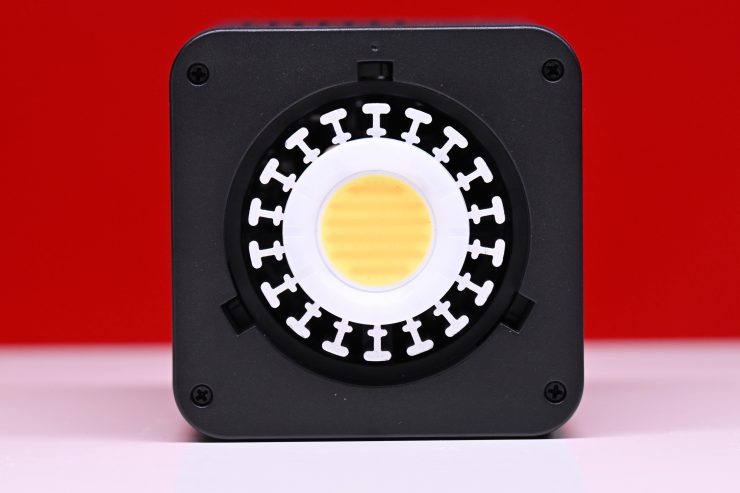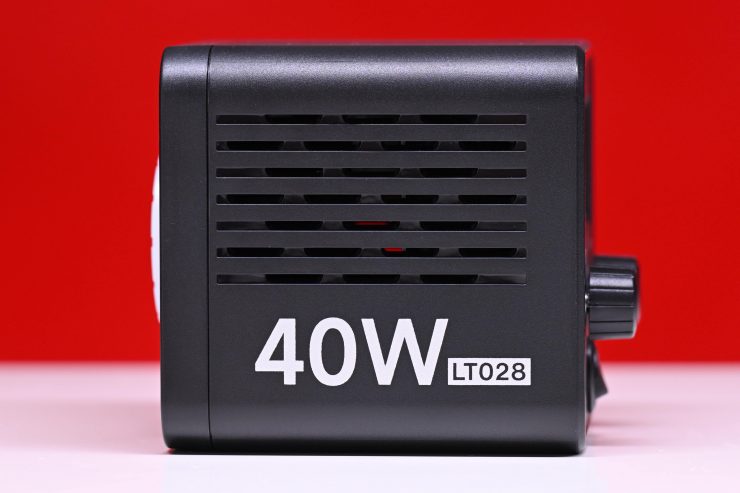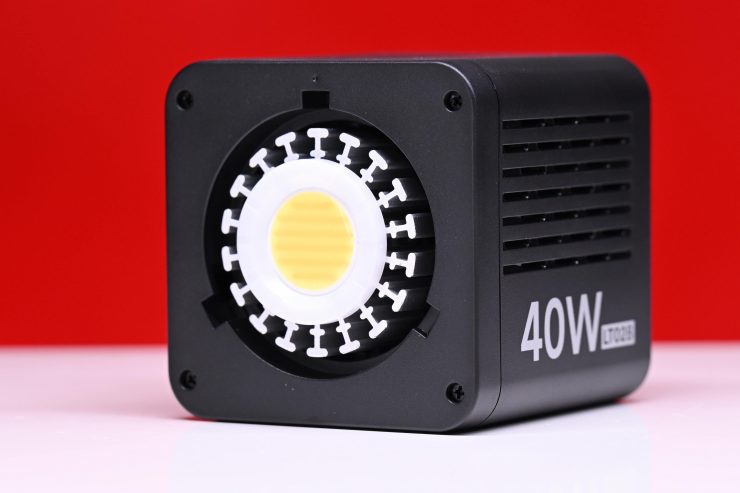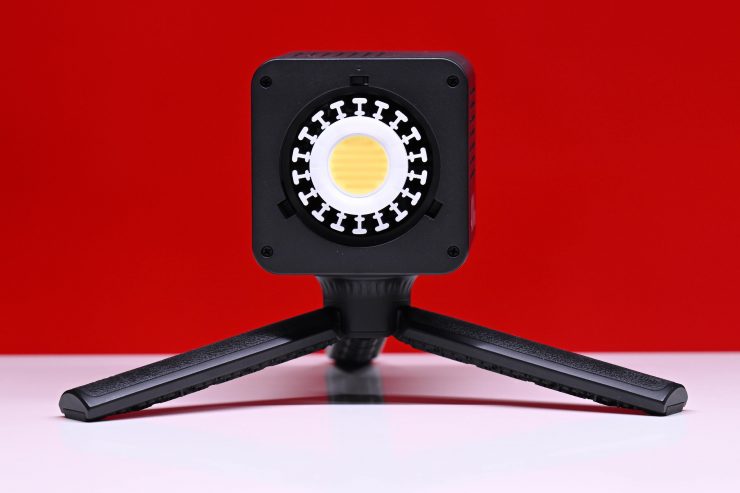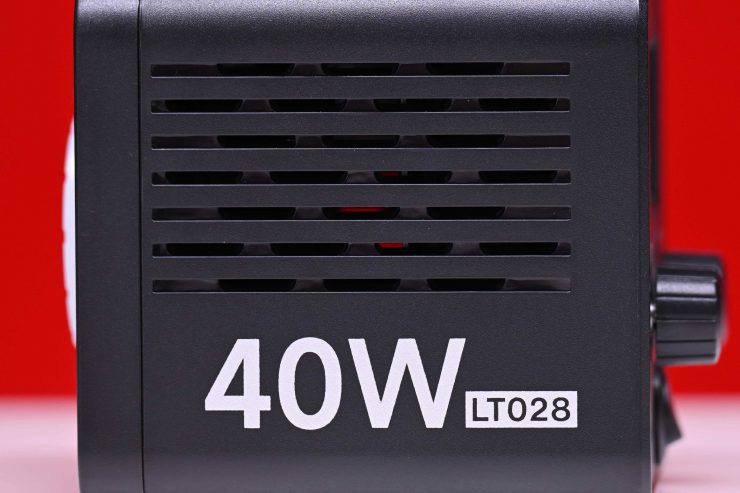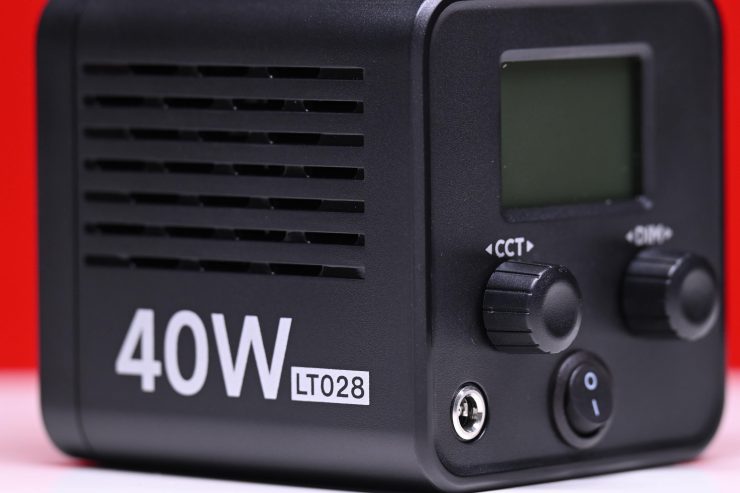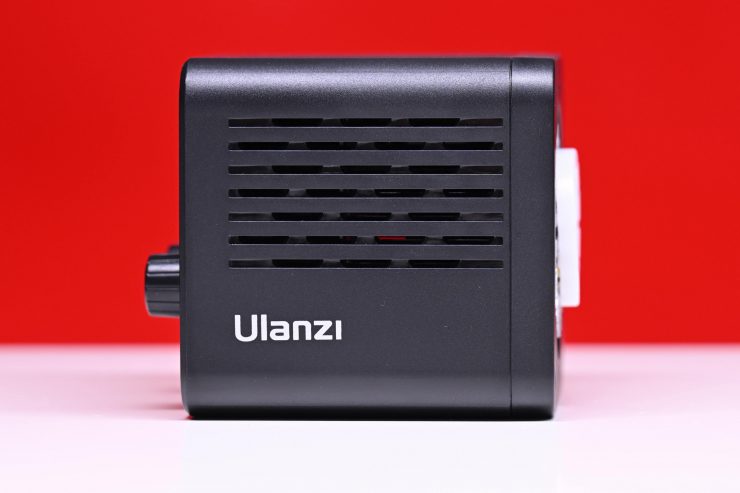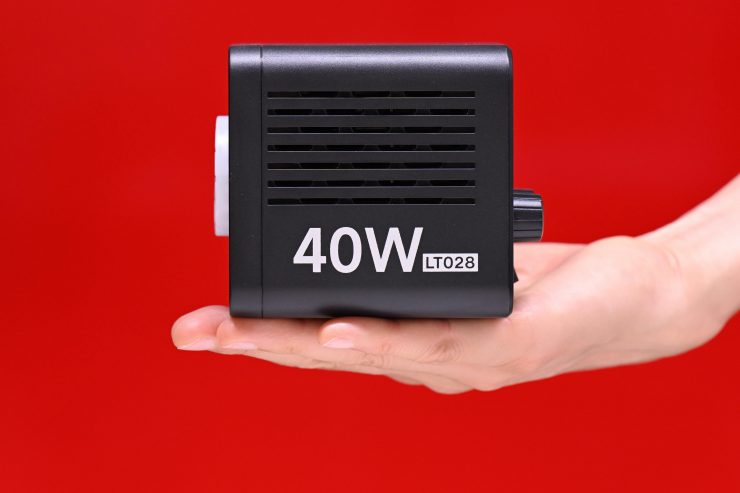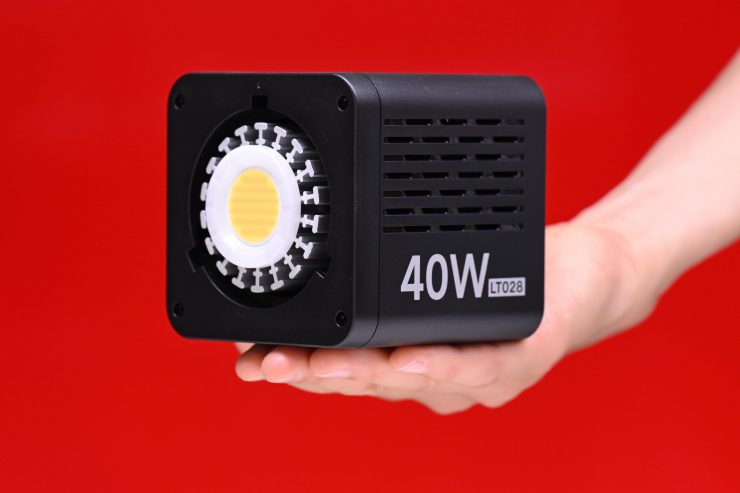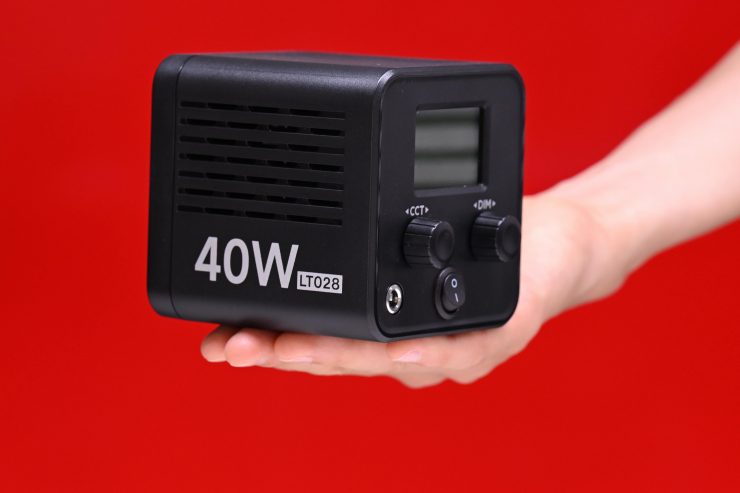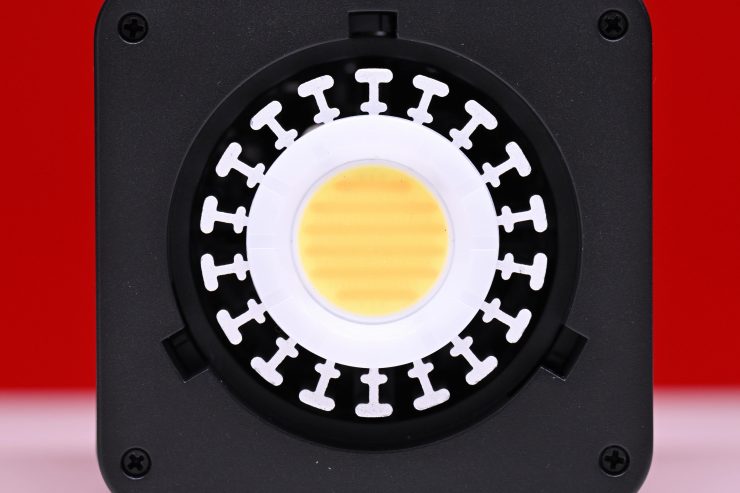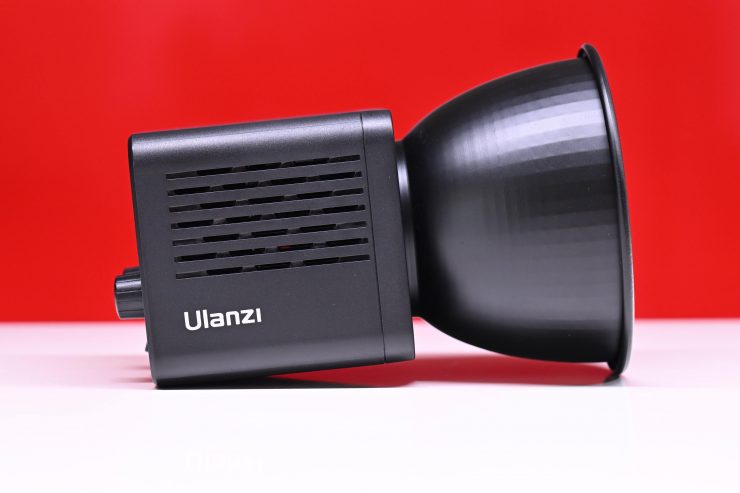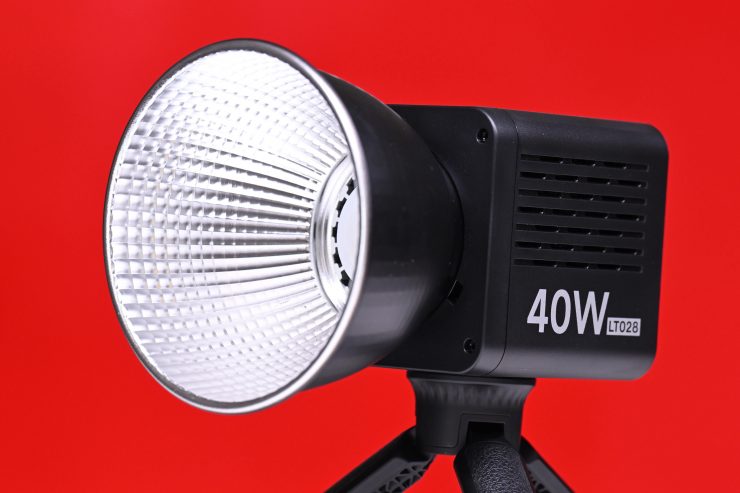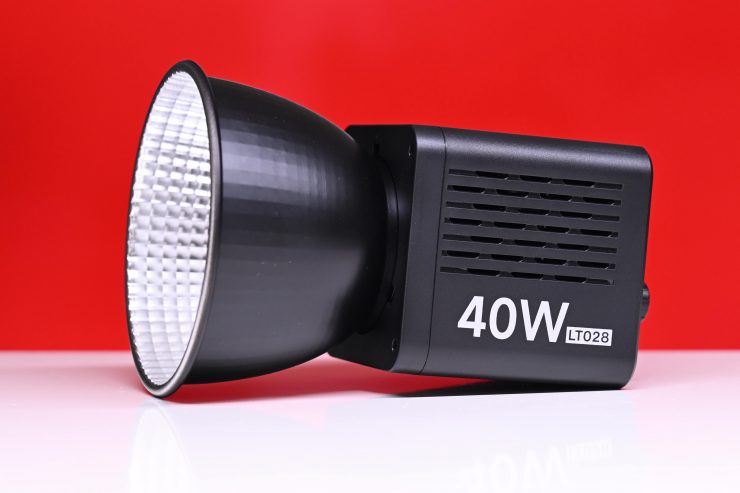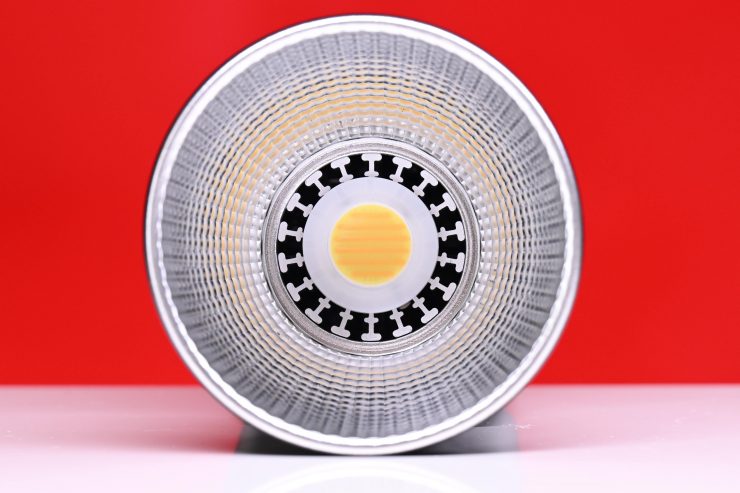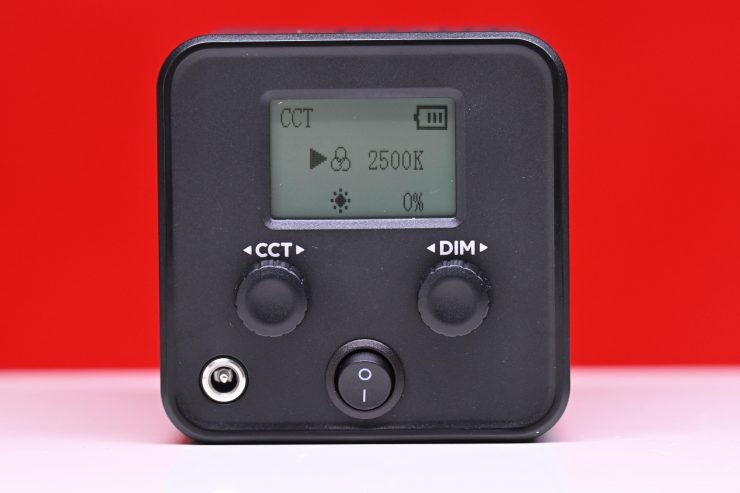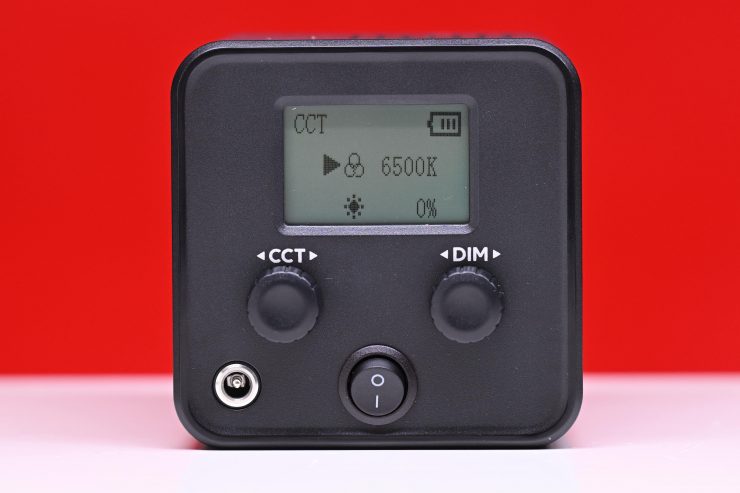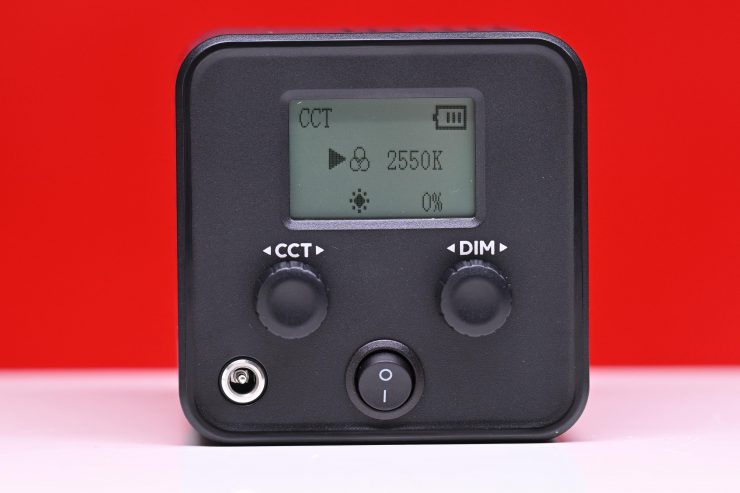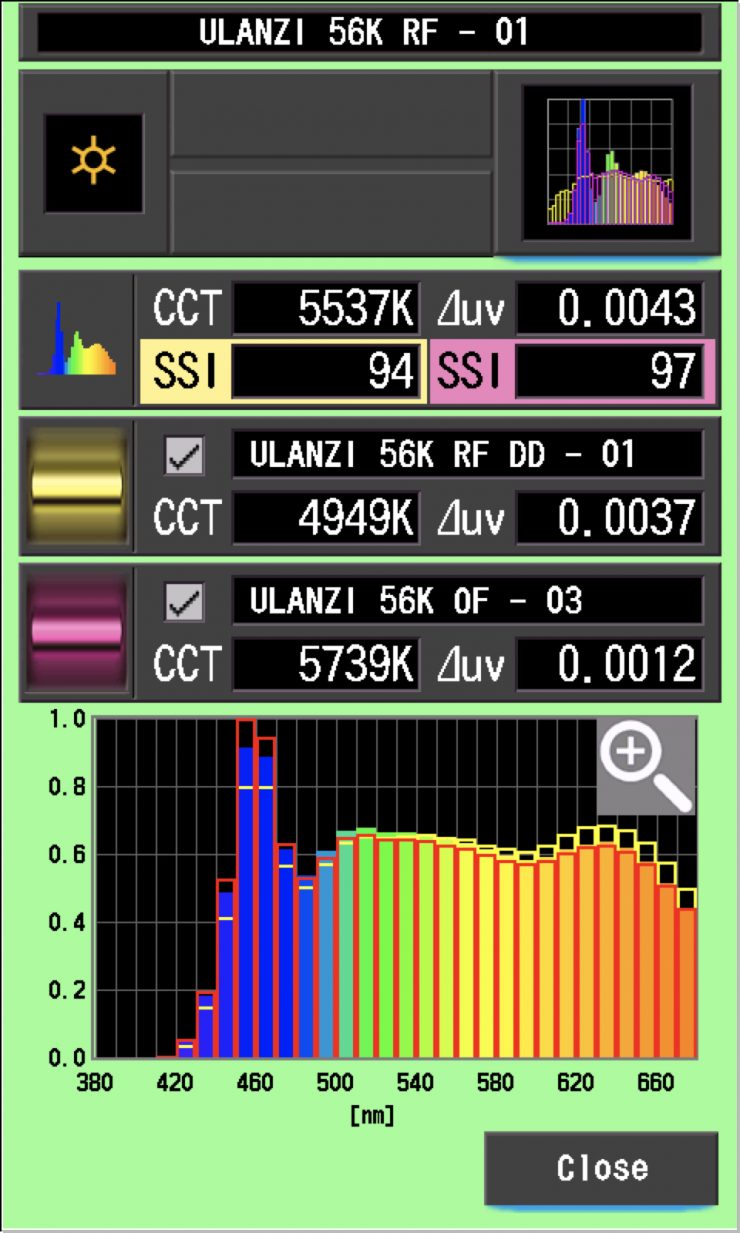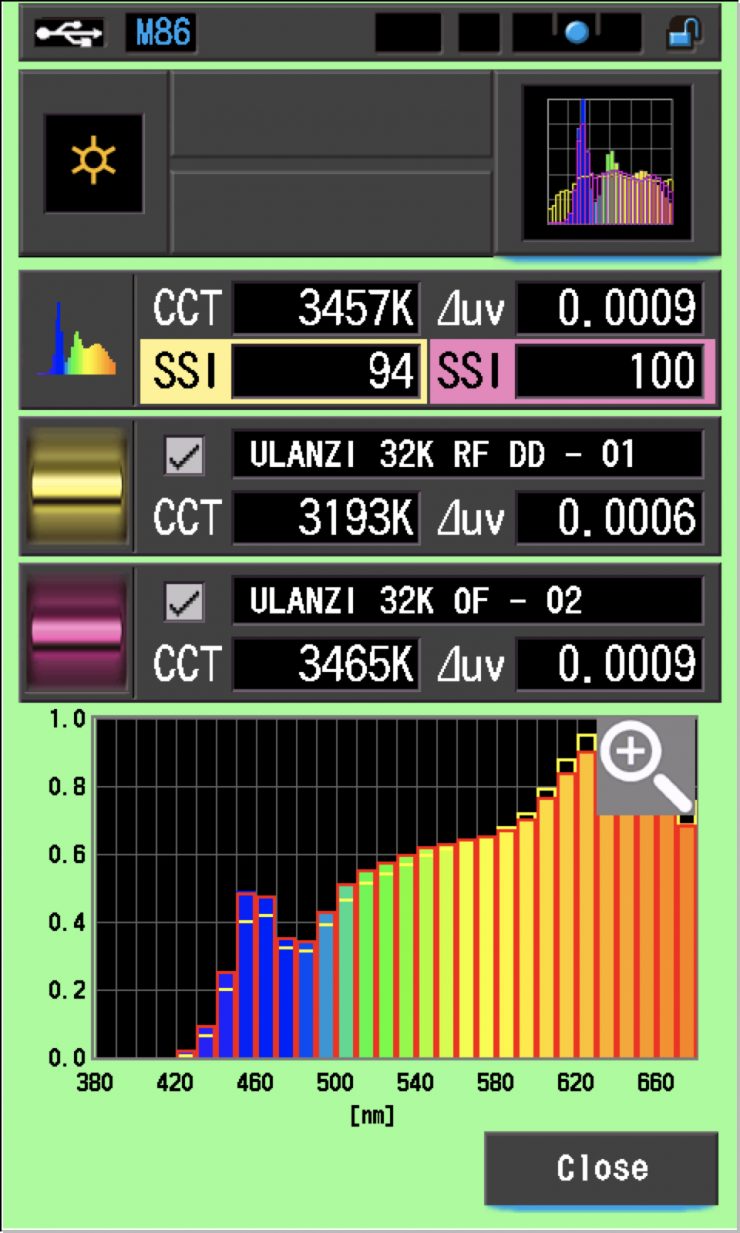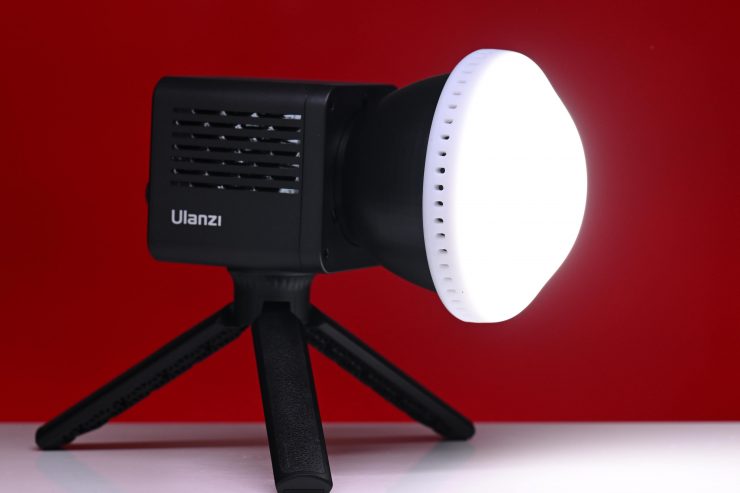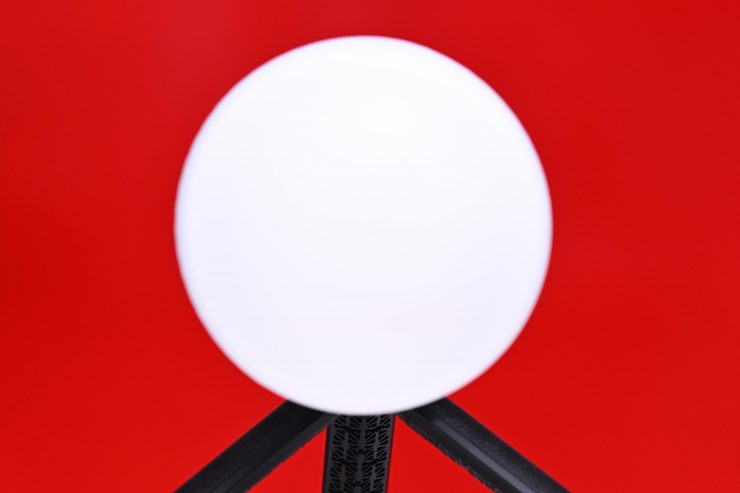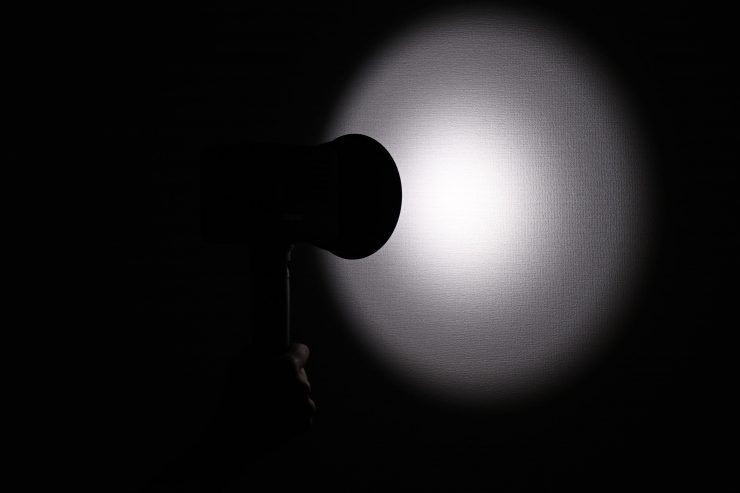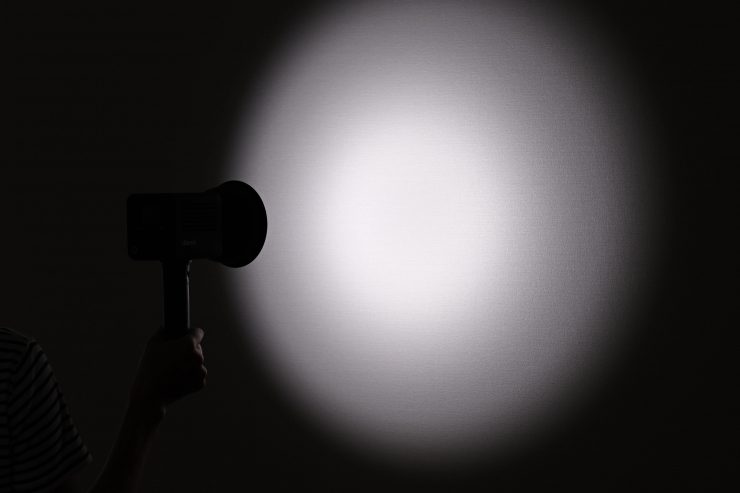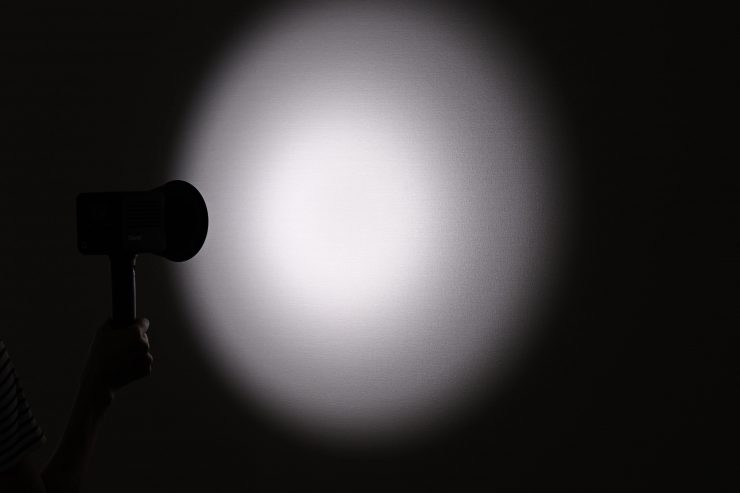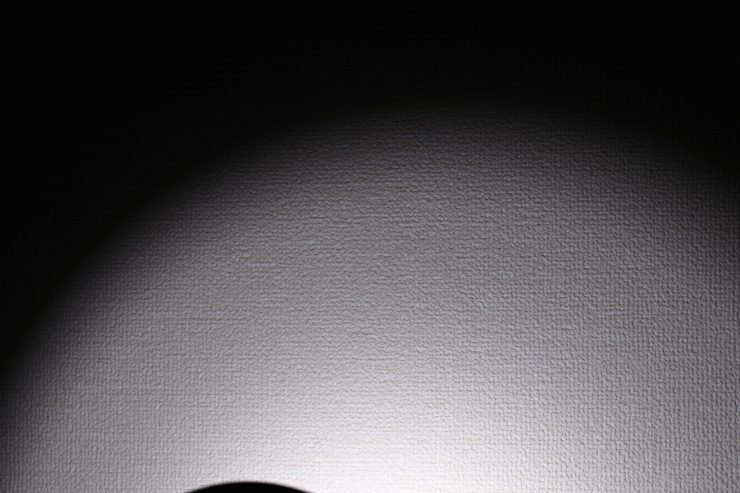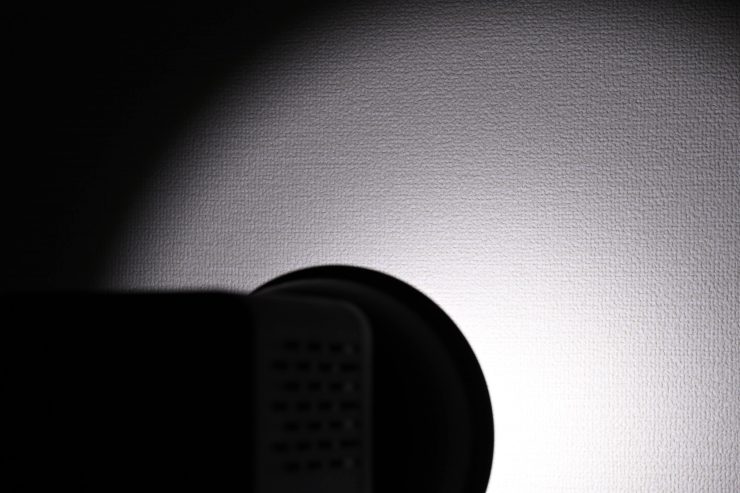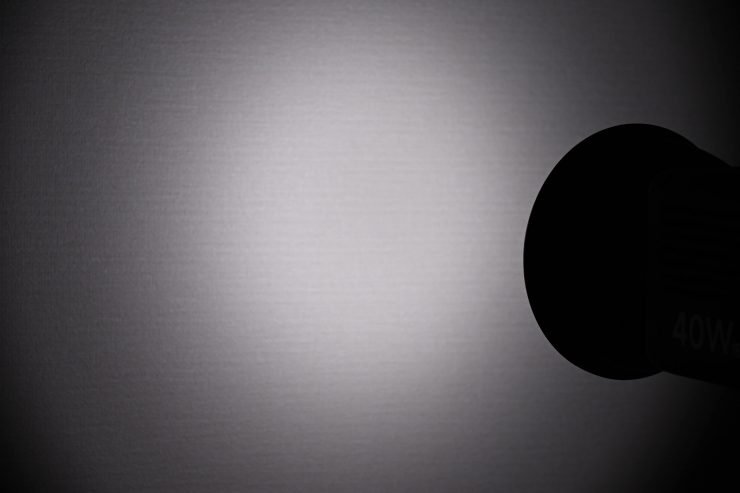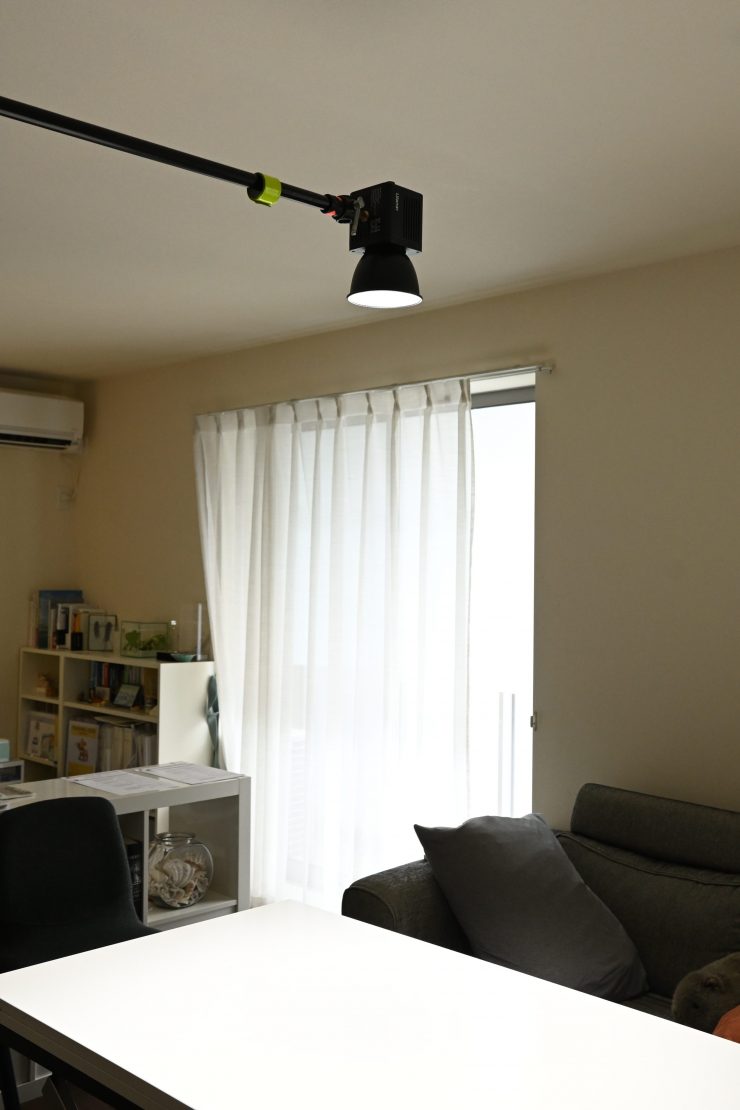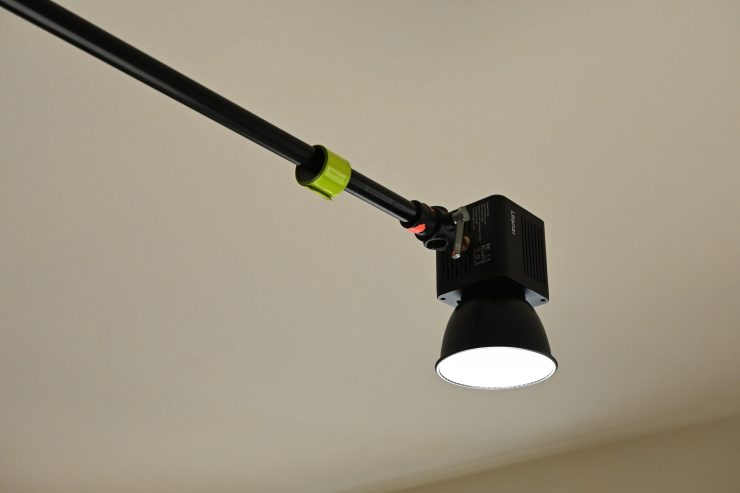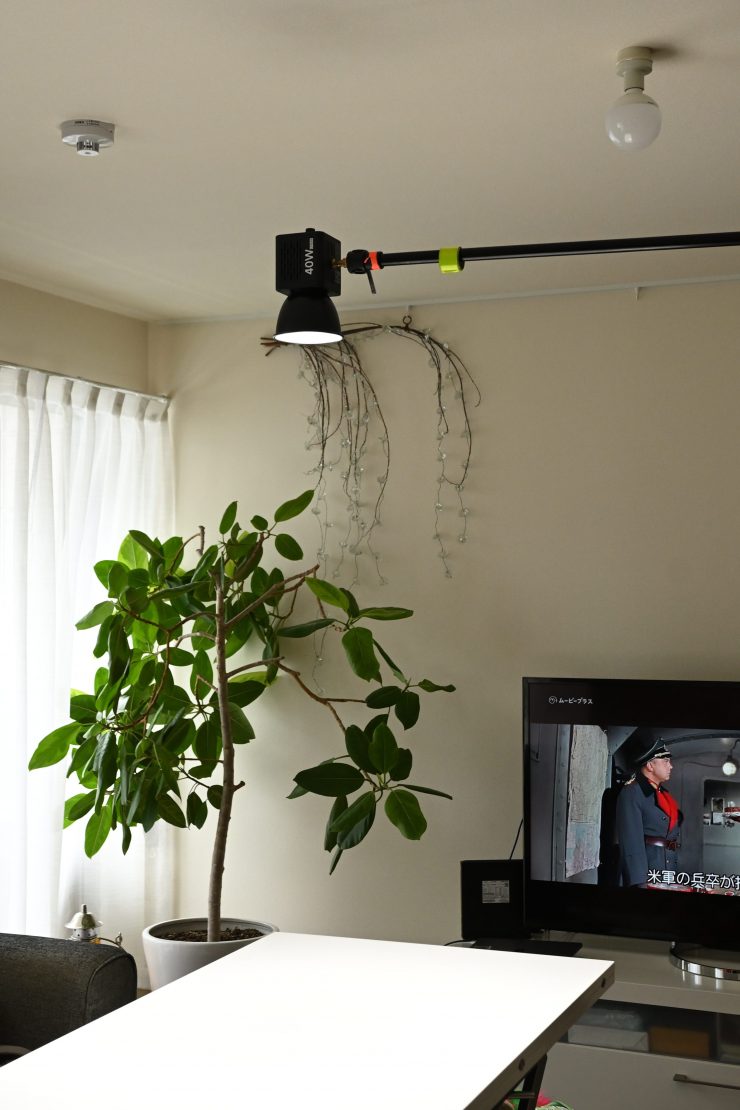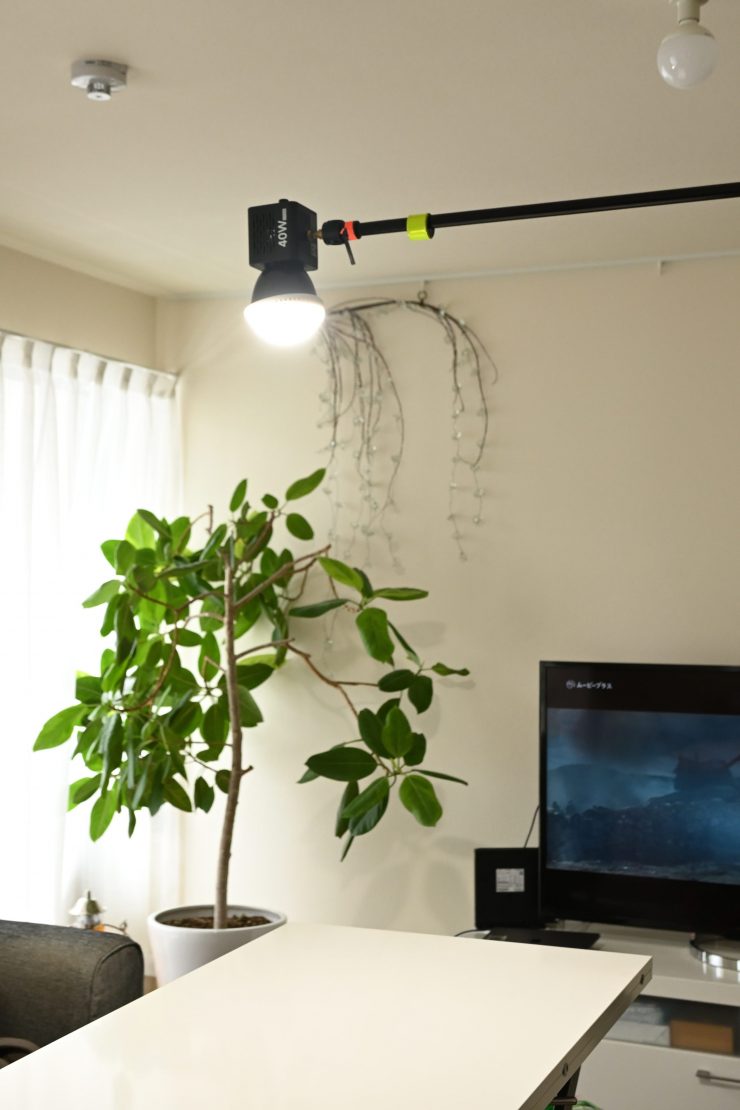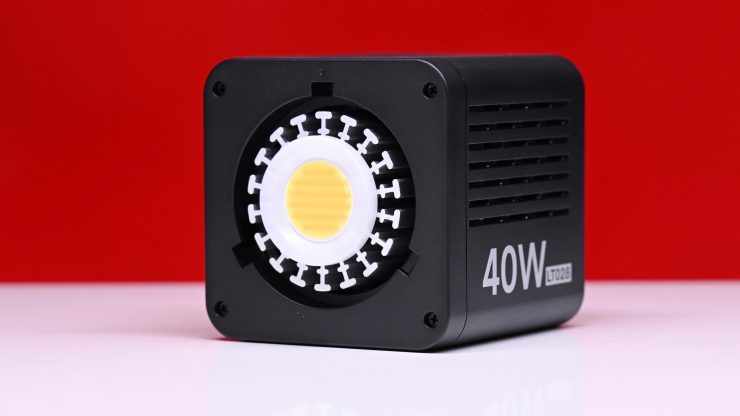
The Ulanzi LT028 40W Portable LED Video Light was designed as a lightweight, handheld fixture for Vloggers and content creators.
We are starting to see a lot of smaller-sized COB lights coming to market and a few of them are now featuring Bowens mounts, however, this particular light uses a mini Bowens mount which means it isn’t compatible with normal Bowens mount accessories.
Key features
- For Content Creators and Vloggers
- Output: 3315 Lux at 3.3′ (6500K)
- 2500-6500K Color Temperature Range
- Powered via Battery or AC Adapter
- Onboard Controls
- CRI | TLCI 96
- Fan Cooled
- Mini Bowens Mount
- 3-Hour Charge Time
- Includes Mini Diffuser
Concept
The concept behind the Ulanzi LT028 was fairly similar to that of a lot of other lighting manufacturers. They wanted to come up with a compact and affordable COB LED light that could be used by Vloggers, content creators, or anyone else that needed a lightweight portable fixture.
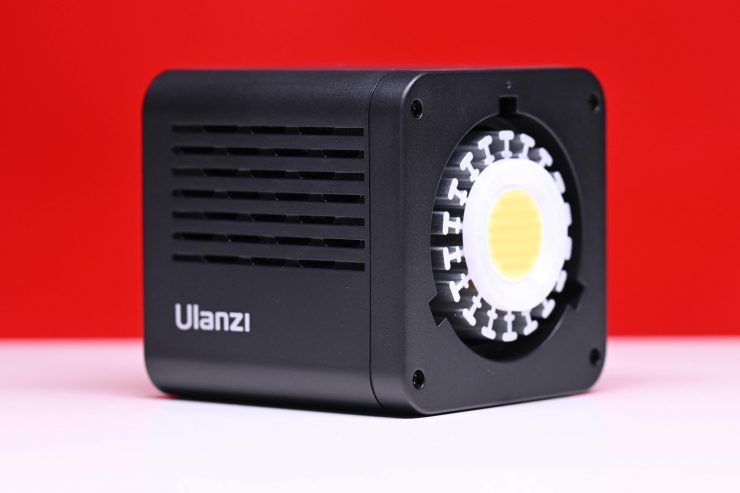
Ulanzi LT028 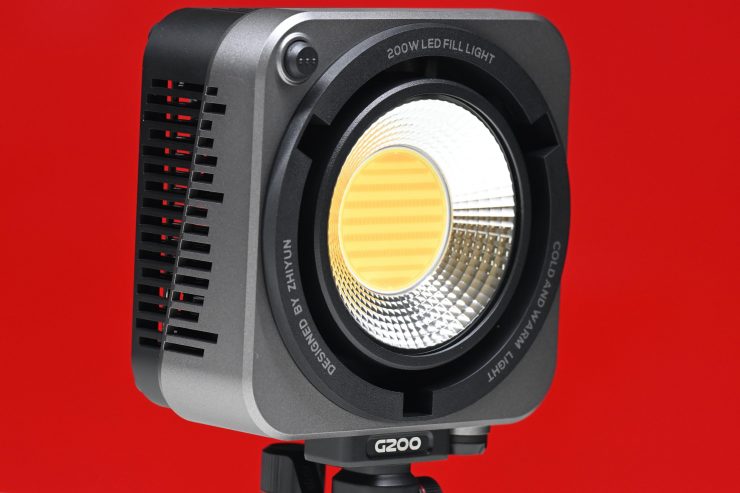
ZHIYUN MOLUS 200
The Ulanzi LT028 features an unusual form factor and it looks quite different from a lot of other LED lights on the market, however, it does share some similarities, and least when it comes to the box-style shape, of the ZHIYUN MOLUS 200 that I recently reviewed.
Everyone seems to be making lights these days
Ulanzi is best known for making camera cages, camera accessories, budget tripods, and phone accessories, but they have now branched out into selling lights as well. They are not alone. We have seen quite a few companies in the last few years that have never sold lights before entering an already crowded market. This competition has undoubtedly brought prices down, but it does make things confusing for consumers with so many choices now available.
Build Quality
The build quality of the Ulanzi LT028 is reasonably good for a light at this price. The casing of the fixture is made out of some type of hard material, although it is not aluminum or steel. I am not sure how it would go if you accidentally dropped it.
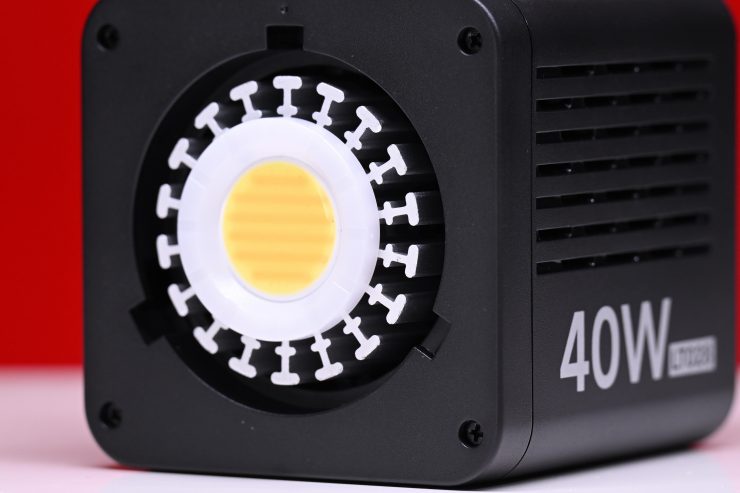
The mini Bowens mount is nice and solid and well made.
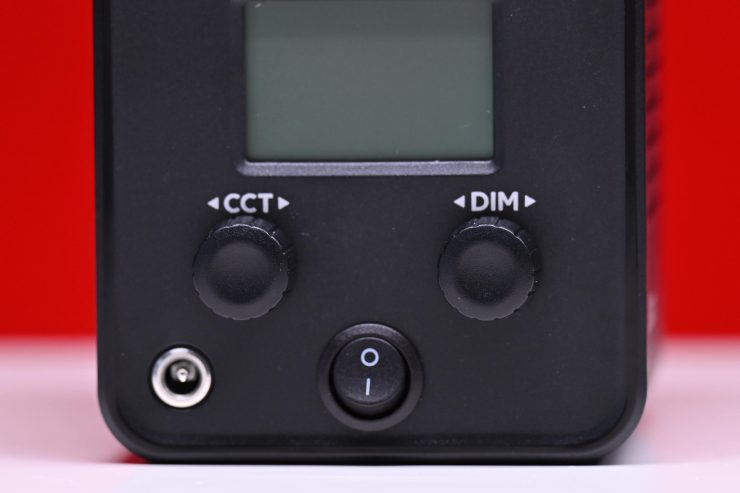
The dimming and CCT adjustment dials are not overly tactile, but they get the job done.
Weight & Size
The Ulanzi LT028 fixture weighs in at just 1.01 lb / 460g. This does make it very lightweight, especially considering that it features an in-built battery. It has physical dimensions of 4.1 x 3.3 x 3.3″ / 10.5 x 8.5 x 8.5 cm.
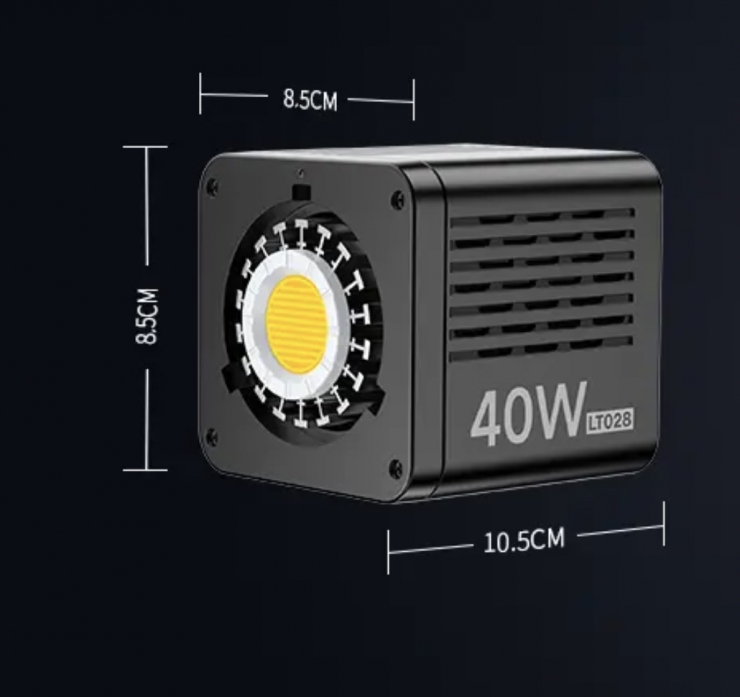
This small size and lack of weight make it an appealing light for anyone who doesn’t like carrying around a lot of gear.
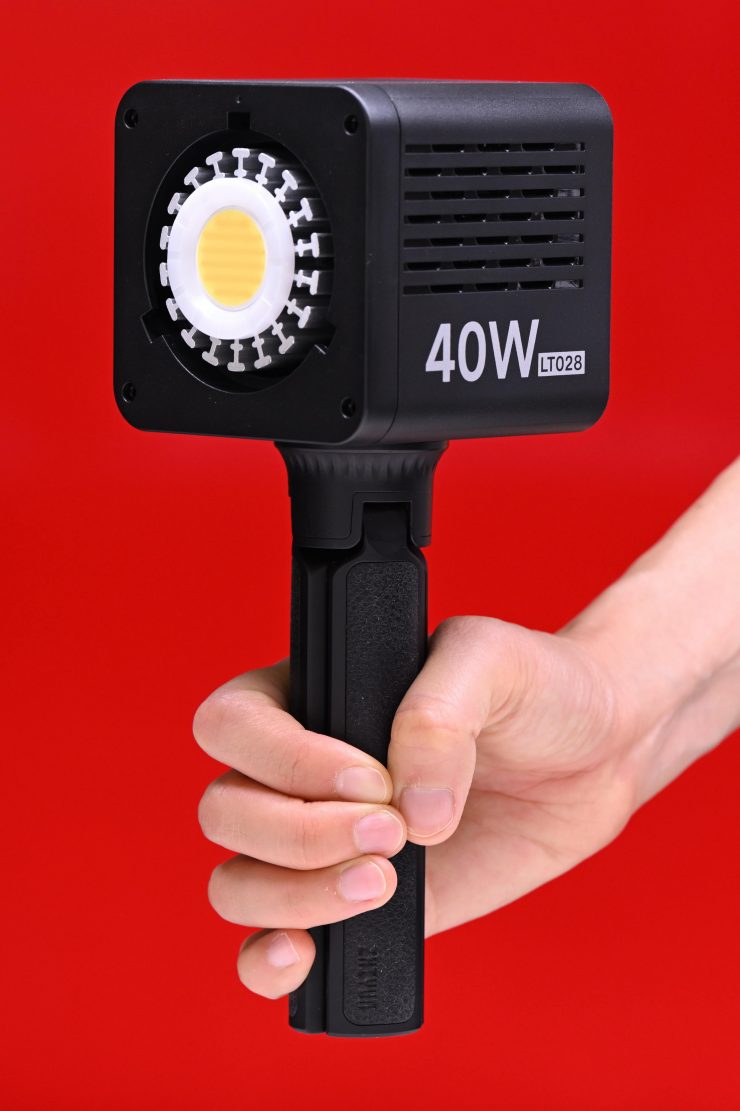
So how does this weight compare to some other lights with a similar power draw that could be considered competition? Well, this is a hard one to answer because there isn’t really any direct competition as I personally don’t know of any other 40W COB lights on the market.
The closest competitor for this light in terms of output would arguably be something like the Genaray Trailblazer T40D Daylight LED Light (40W) which weighs in at 1.3 lb / 590g.
Something a little more powerful like the amaran COB 60x S Bi-Color LED Monolight weighs 1.19kg / 2.63 lb, while the Nanlite FS-60B Bi-Color Studio Spotlight weighs 848 g / 1.87 lb.
Mini Bowens Mount
The light doesn’t feature a full-size Bowens mount, instead, it utilizes a Mini Bowens mount.
This isn’t a massive problem as there are numerous companies that make affordable Mini Bowens to Bowens-S mount adapters. With one of these adapters, you can run a much wider array of affordable lighting modifiers.
Bear in mind that this is a small, lightweight fixture and if you tried to run any type of lighting modifier that was too big or heavy it could potentially break the mount.
Power Draw & Internal Battery
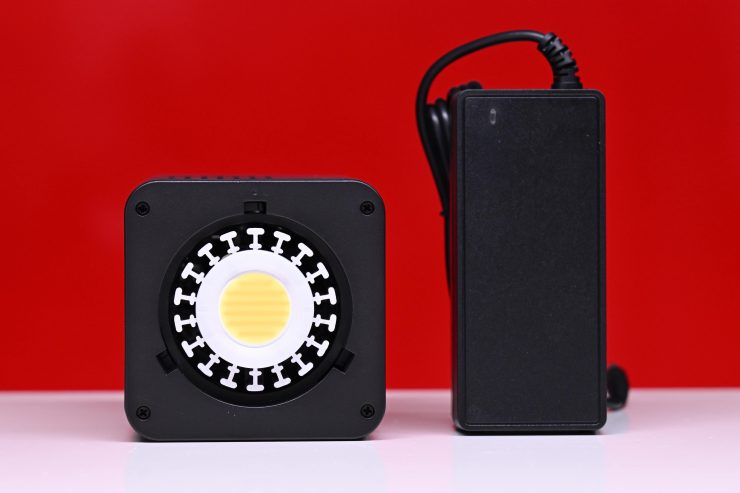
The Ulanzi LT028 draws a maximum of 40W, which is not a lot.
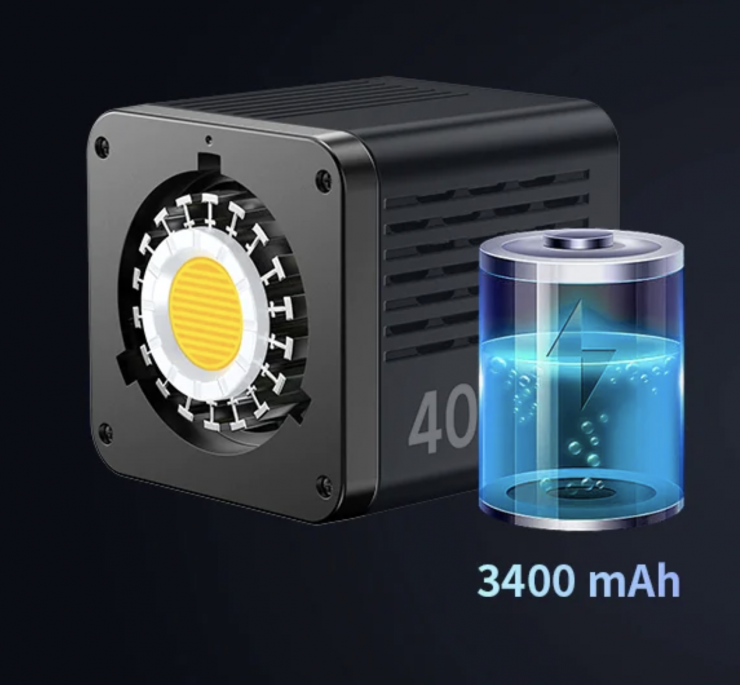
The Ulanzi LT028 features an in-built, rechargeable 3400mAh High-capacity Battery, but it can also be powered via a DC power adapter. Ulanzi claims that when using the built-in 3400mAh high-capacity battery, it can be run continuously for up to 5 hours, although at 100% output, it will only run for up to 75 minutes. It also supports charging while in use.
The battery takes around 3 hours to fully charge.
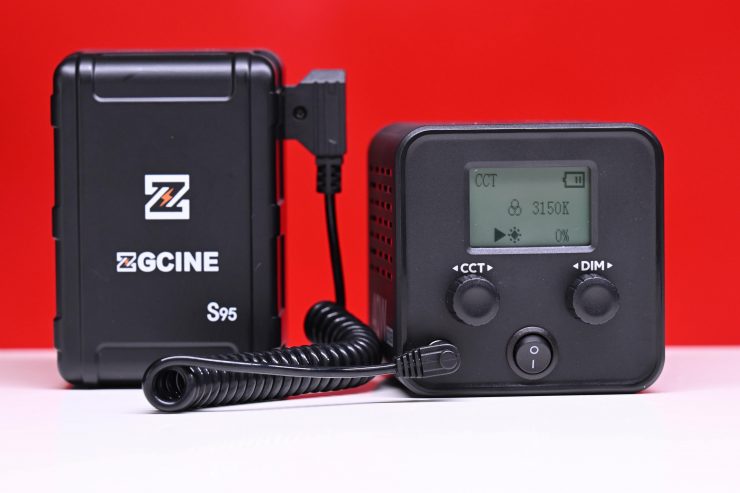
The caveat with the Ulanzi LT028 is that it doesn’t feature any battery plates, however, you could run it from a camera battery by using a DC barrel to D-tap power connector.
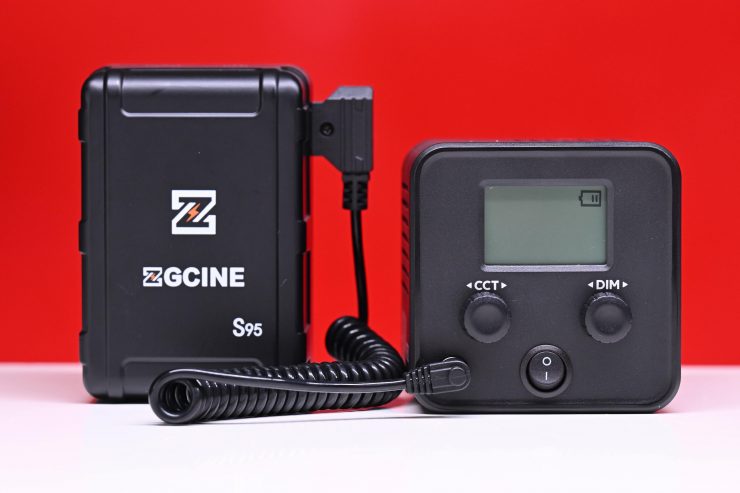
You can also use this same set-up to charge the internal battery.
While there is nothing wrong with being able to do this, I would have preferred to have seen some sort of detachable Sony NP-F battery plate as people looking at a 40W sub $100 USD light are arguably not going to own V-mount or AB Gold mount batteries with D-taps.
How does it stay cool?
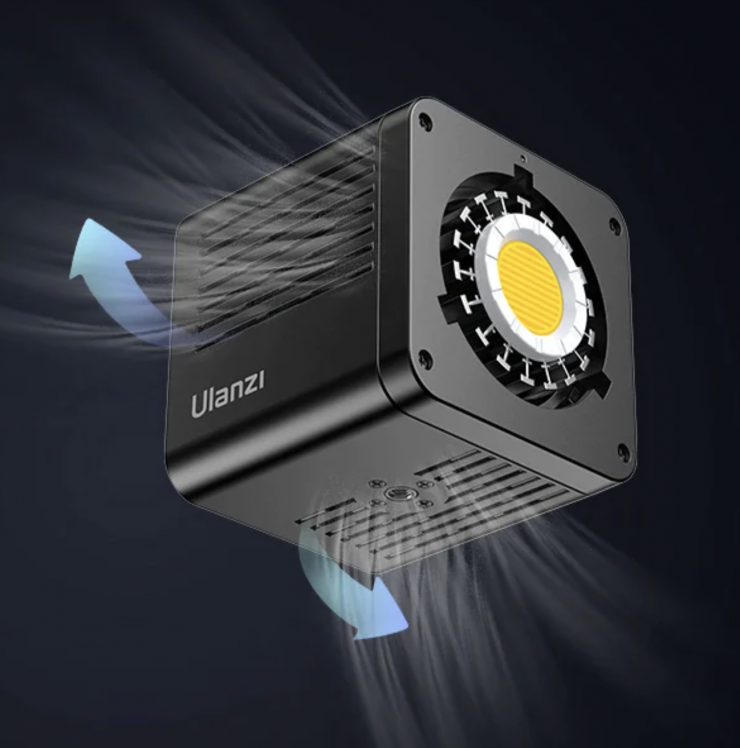
COB LED lights generate a lot of heat, and they need to be cooled to operate correctly. The Ulanzi LT028 features a built-in cooling fan to prevent overheating. There are also ventilation slots on four sides of the light.
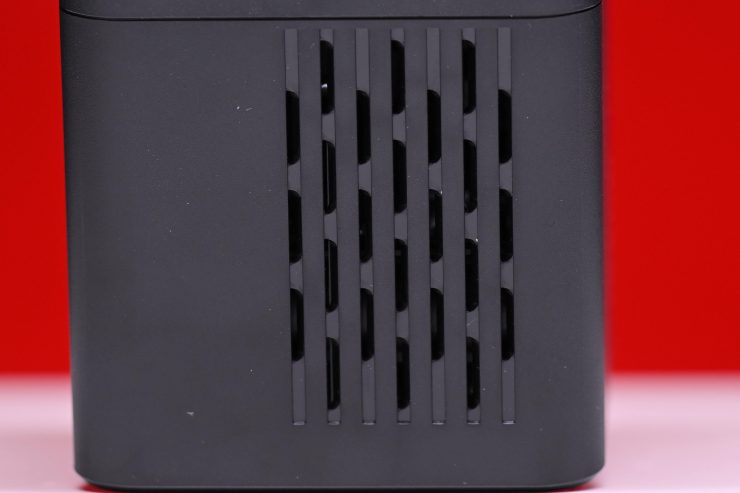
Despite having a fan, there are no controls to adjust the fan.
The fan is reasonably quiet even when operating at 100% output for long periods of time, however, because it has a limited amount of output you are going to have to place it closer to the talent so this could be an issue if you are recording audio in a quiet location.
What I liked is that the fan noise remains constant and it doesn’t ramp up or ramp down. I much prefer a constant level than a varying one, because at least you know what to expect when it is constant.
Beam Angle
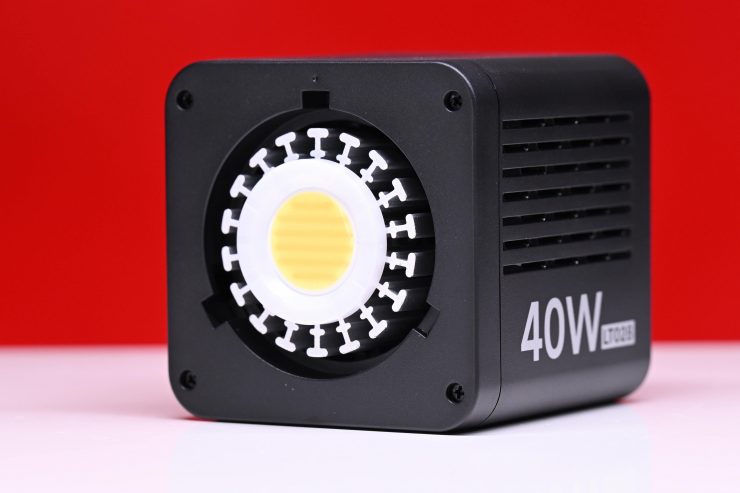
The native beam angle of the LT028 when used open face is 105 degrees. This is reasonably wide and handy for a lot of situations where you want to create a broad spread of light.
You can alter that beam angle by using the included reflector. The beam angle with the reflector is 55 degrees.
Mounting
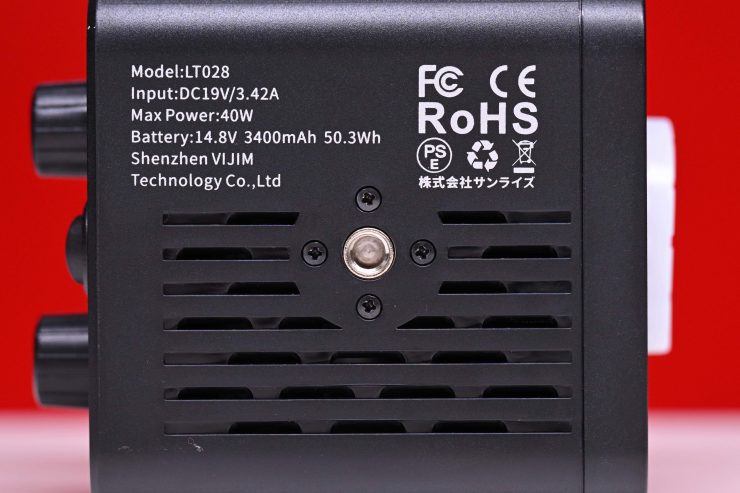
The light features a single 1/4-20″ mounting hole and the review unit I had didn’t come with any type of adjustable mount to use on lightstands.
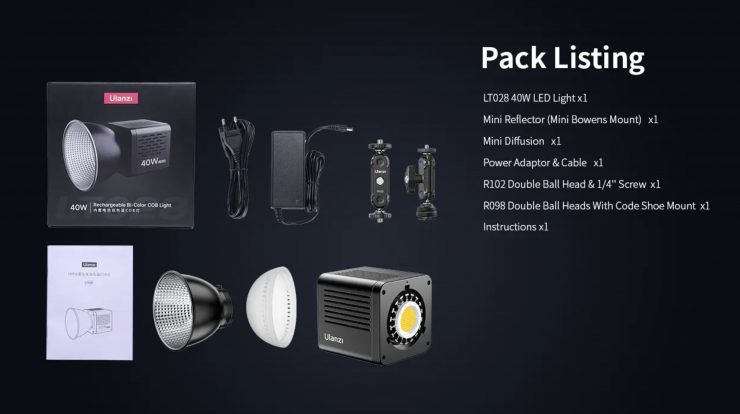
However, Ulanzi’s website does show that the light does come with a couple of ballhead mounts. This wasn’t the case a few weeks ago.
Controls & Menu System
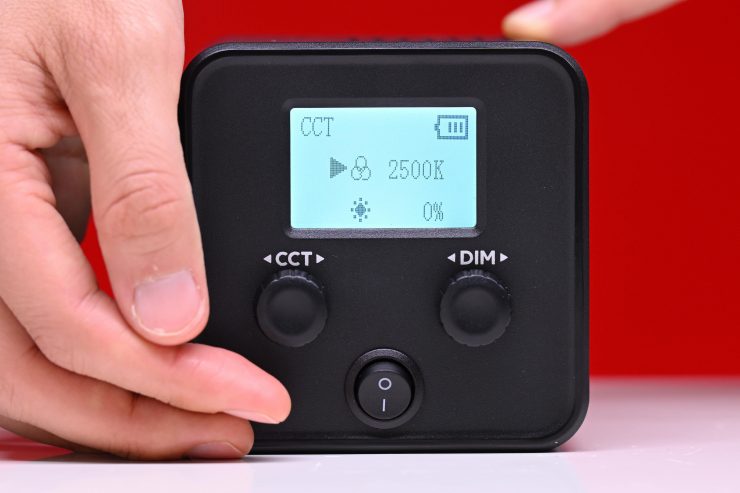
The control interface that is located on the back of the light is about as basic as you will get.
There is a reasonably large display screen and two dials for adjusting CCT and Dimming. You can adjust the CCT from 2500-6500K, as well as the intensity. The CCT adjustment can be changed in 50K increments.
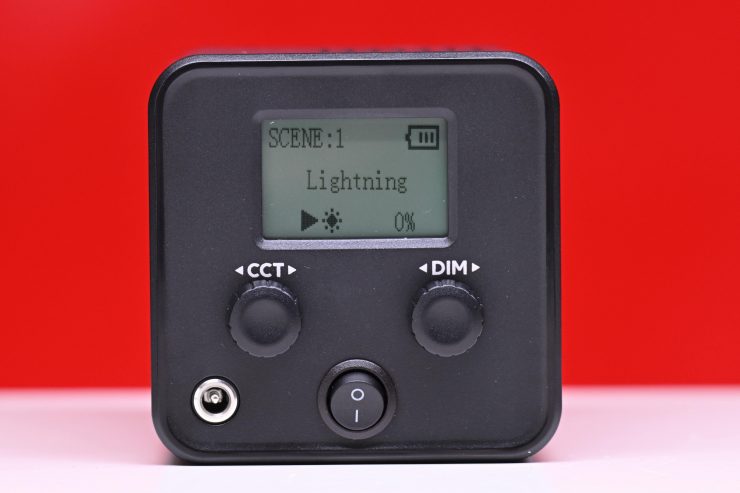
To access the effects mode you simply press the CCT dial.
The display turns darker about 3 seconds after you make an adjustment.
While there is nothing overly fancy about the interface, it does the job, and that is probably all you should expect for a light at this price.
As I always say, the hallmark of a good operating system is that you shouldn’t have to read a manual to work out how to use it. You should be able to turn it on and use it straight away. Without any complex menus or lots of options, the LT028 is going to be easy to operate for anyone.
Operating Modes
The light has two operating modes:
- CCT
- Effects Mode
Correlated Color Temperature (CCT)
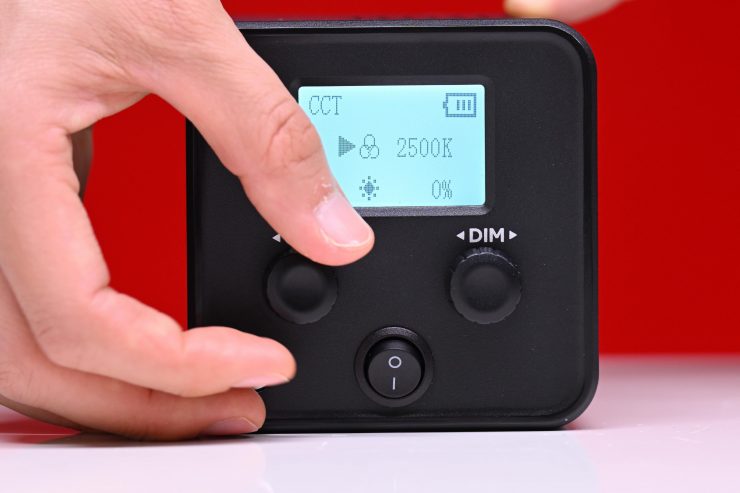
In the CCT Mode, you have full access to making CCT adjustments between 2500-6500K. This isn’t a massive adjustment range, but it will suit most people’s needs.
The fixture doesn’t feature any continuous variable (full minus green to full plus green) correction, but I wouldn’t expect a light that retails for under $100 USD to have it.
Effects Mode
In the effects mode you can choose from the following effects:
- Lightning
- TV
- Candle
- Faulty Bulb
- Strobe
- Paparazzi
- Emergency
- H/L Beam
You can only adjust the intensity of the effects. There are no controls for changing their speed.
Photometrics
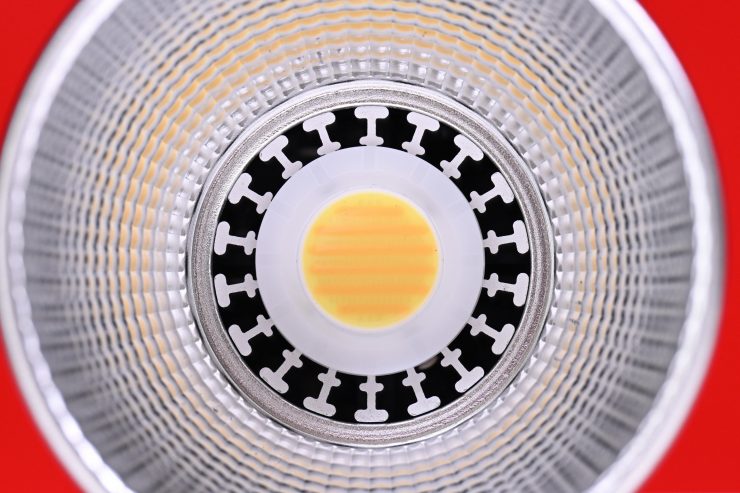
So now let’s get to the photometric results. I always test lights in this way so that I get a reference to how they compare to other fixtures. Results only tell part of the story and should never be used alone to judge a light. I have found from extensive testing over the years that certain lights that have good photometric results don’t always look good, and lights that have worse photometric scores can sometimes look better than their results indicate.
You can’t judge a light from one set of photometric results. SSI, while great, doesn’t provide you with all of the information you need. You have to look at all of the different results to be able to come to a conclusion. Judging alight on one set of results is like reading one chapter in a book and thinking you know the whole story.
Different lights can also look different depending on what camera you happen to be using.
It doesn’t matter whether a light costs $8,000 USD or $80 USD, it will still undergo the same thorough testing that I do with any fixture.
Output & Color Temperature Accuracy
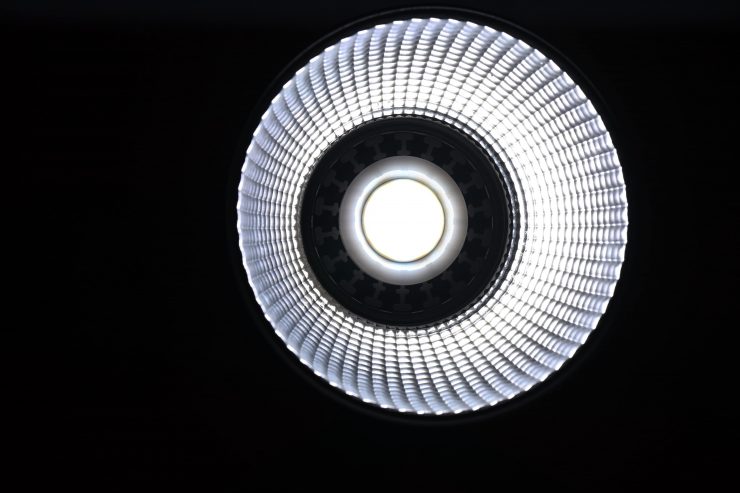
According to Ulanzi, the LT028 is capable of outputting 3315 Lux at 3.3′ when used at 6500K with its included reflector.
I tested the Ulanzi LT028 at a variety of CCT settings with a Sekonic C-800 Spectrometer to find out how much output the light had and how accurate the CCT reproduction was. All readings are taken at a distance of 1m (3.28ft) in a controlled environment. The readings were all taken directly from the lighting source. In the case of using the light with a Reflector or any attachment, the readings were taken from the edge of those attachments. This is how I test all lights.
So just how much output does it have? Well, let’s find out.
Ulanzi LT028 5600K (open face)
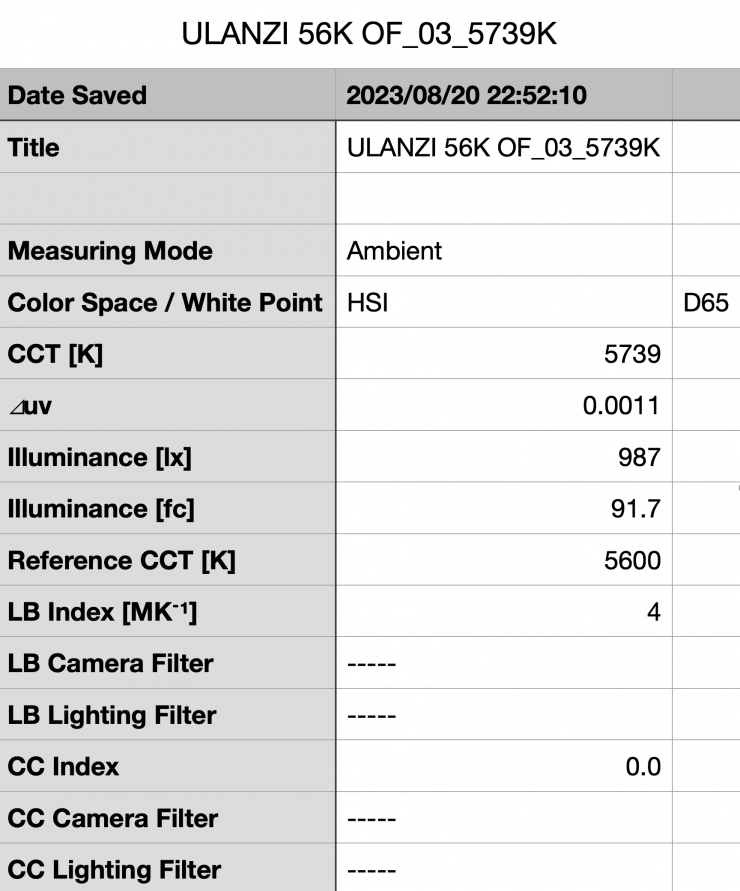
Above you can see the Ulanzi LT028 recorded an output of 987 lx (91.7 fc) when set at 5600K and used open face.
This is not a lot of output. As a comparison, the higher power draw (65W) amaran COB 60x puts out 2940lx at the same distance when used open face.
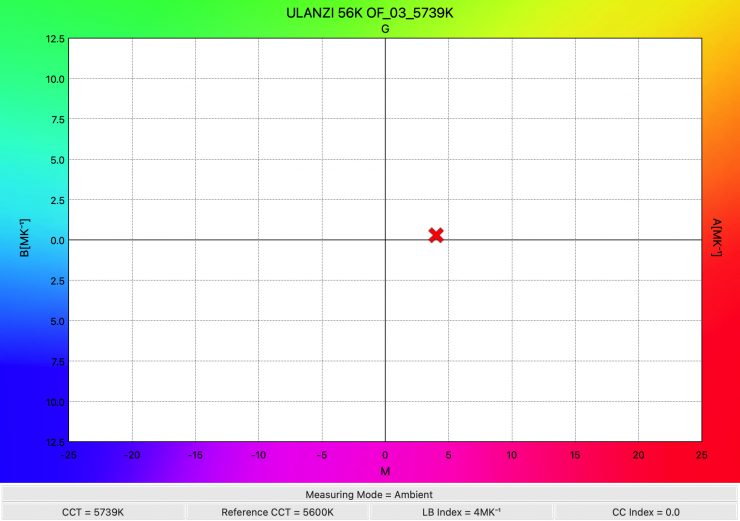
The light recorded a CCT reading of 5739K which was almost 140K from being correct.
Ulanzi LT028 3200K (open face)
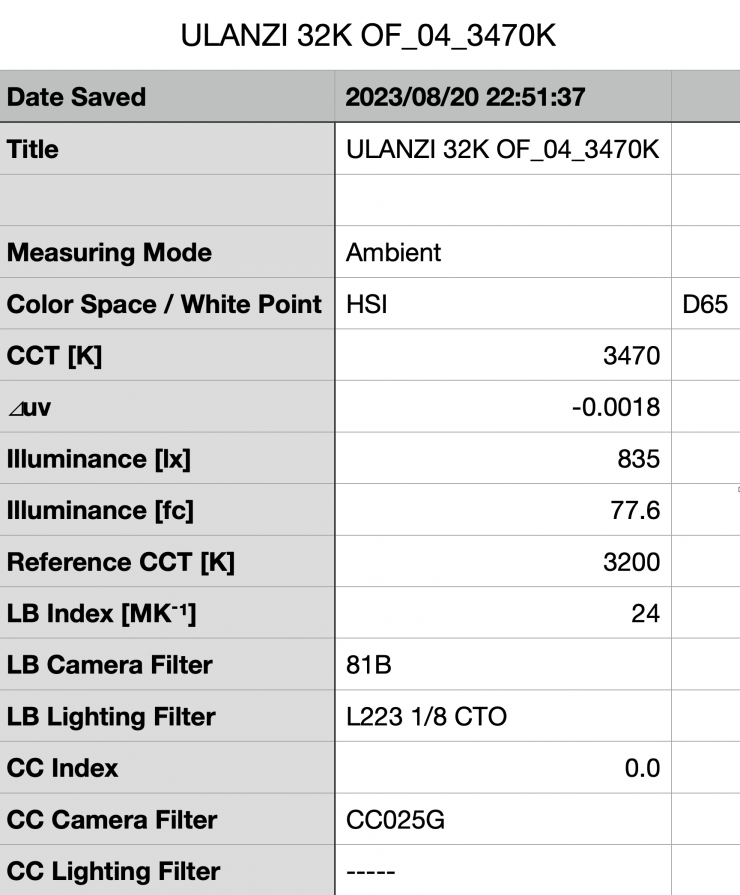
Above you can see the light’s output when it was set at 3200K in the open face configuration was 835 lx (77.6 fc), which was 15.4% less than it produced at 5600K.
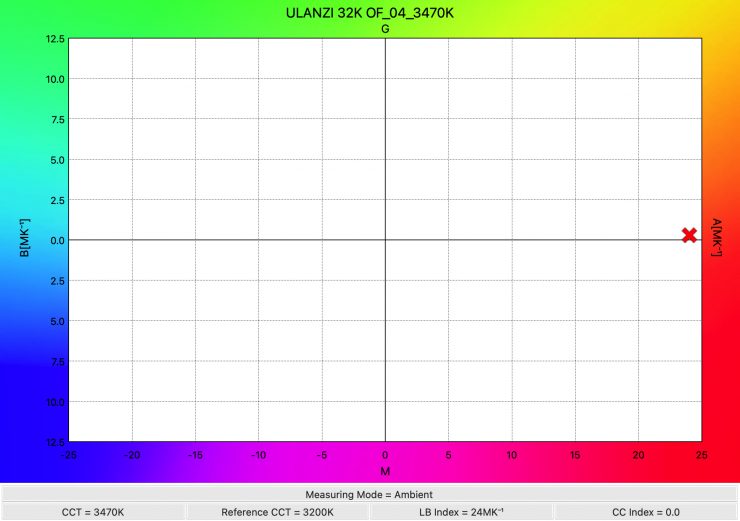
As far as CCT accuracy goes, it recorded a reading of 3470K, which was more than 150K off being correct.
Ulanzi LT028 5600K Reflector
Now, that we have seen some results when it was used open face, what happens if we use it with the included reflector?
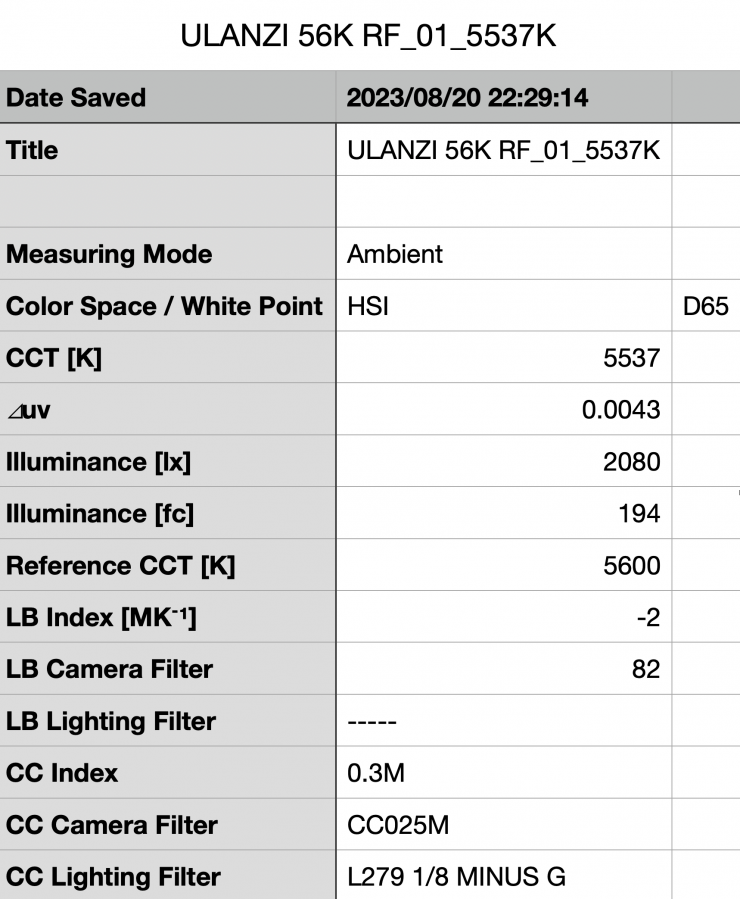
Above you can see the light’s output when it was set at 5600K with its reflector was 2080 lx (194 fc), which was 110.7% more than it put out when used open face.
As a comparison, the higher power draw (65W) amaran COB 60x puts out 32,000 lx at the same distance when used with its reflector. Although, the reflector on this light is a very tight 15 degrees as opposed to the 55 degrees of the Ulanzi.
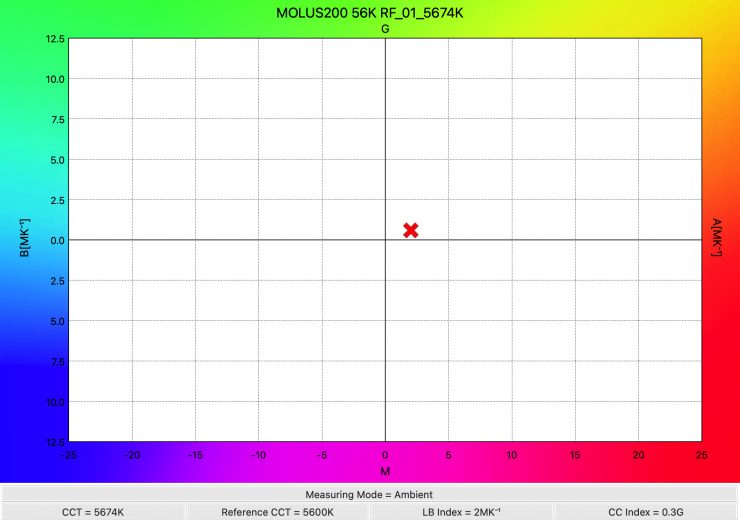
As far as CCT accuracy goes, it recorded a reading of 5674K, which was a lot better than the 5739K it recorded when used open face. This clearly tells me that the reflector alters the CCT but in a good way.
Ulanzi LT028 3200K Reflector
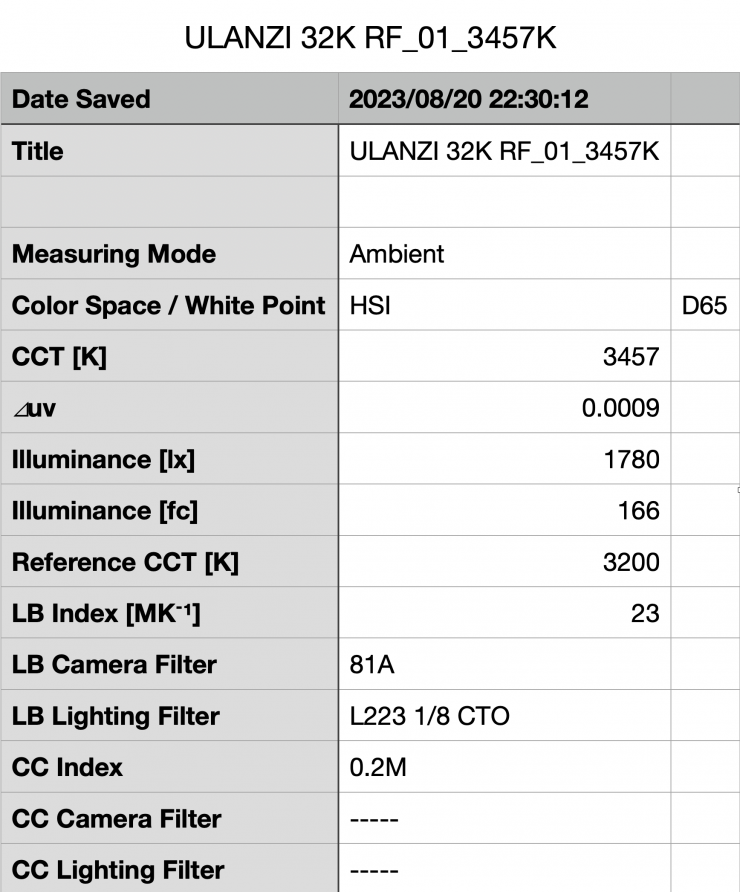
Above you can see the light’s output when it was set at 3200K using its reflector was 1780 lx (166 fc), which was 113.1% more than it produced when used open face.
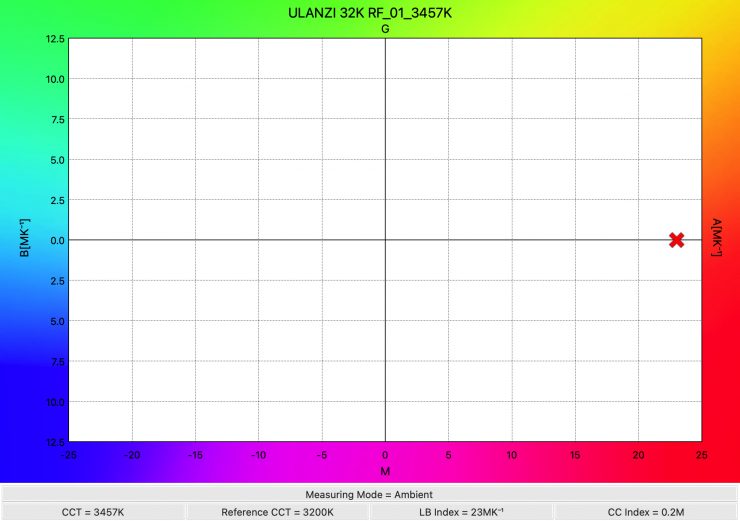
As far as CCT accuracy goes, it recorded a reading of 3457K which wasn’t too far off the 3470K it produced when used open face.
This tells me that the reflector doesn’t alter the CCT too much when used at 3200K.
Ulanzi LT028 5600K Reflector & Diffusion Dome
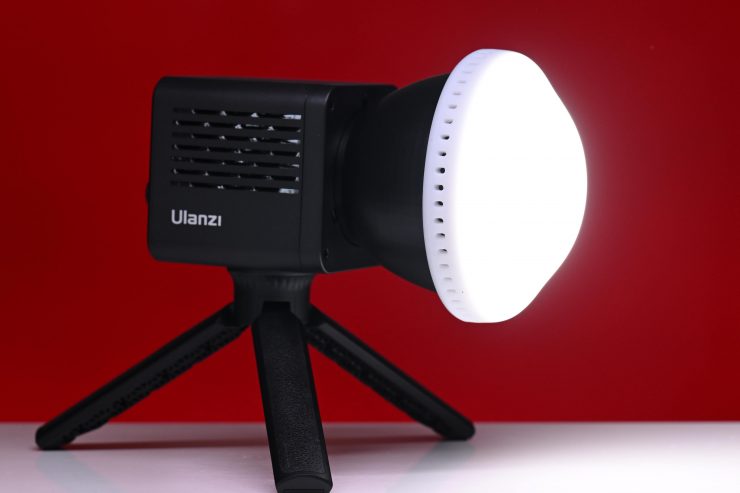
I wanted to test how much output the Ulanzi LT028 had when used with its reflector and diffusion dome.
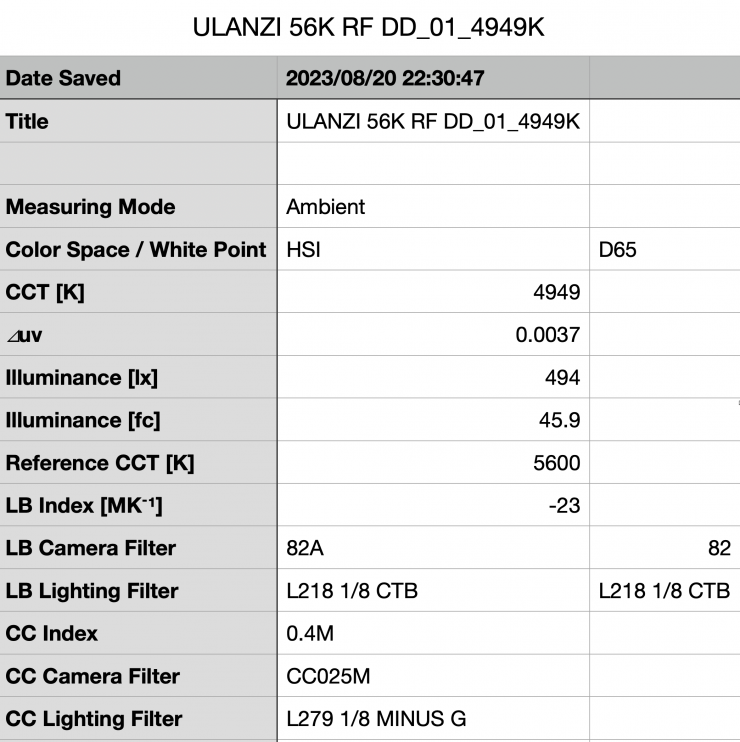
Above you can see the light’s output when it was set at 5600K using its reflector and diffusion dome was 494 lx (45.9 fc).
494 lx is not a lot of output and you would struggle to do much with the light in this configuration.
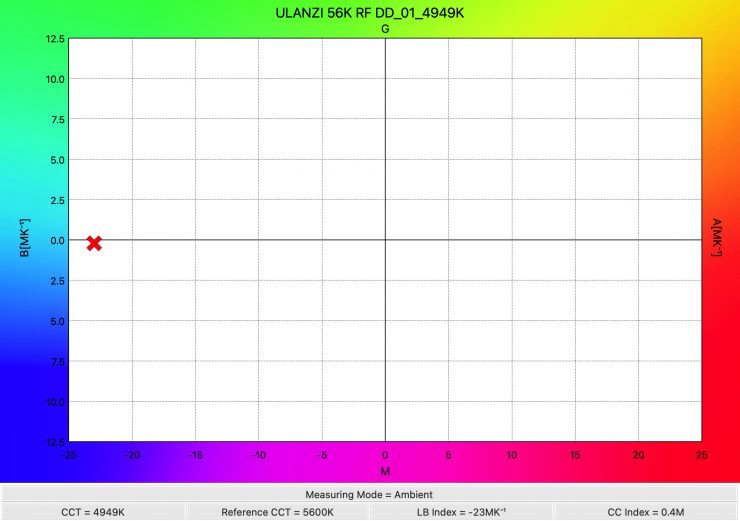
As far as CCT accuracy goes, it recorded a reading of 4949K which was more than 650K from being correct. The combination of the reflector and diffusion dome massively alters the CCT reading and you need to clearly be aware of this.
Ulanzi LT028 3200K Reflector & Diffusion Dome
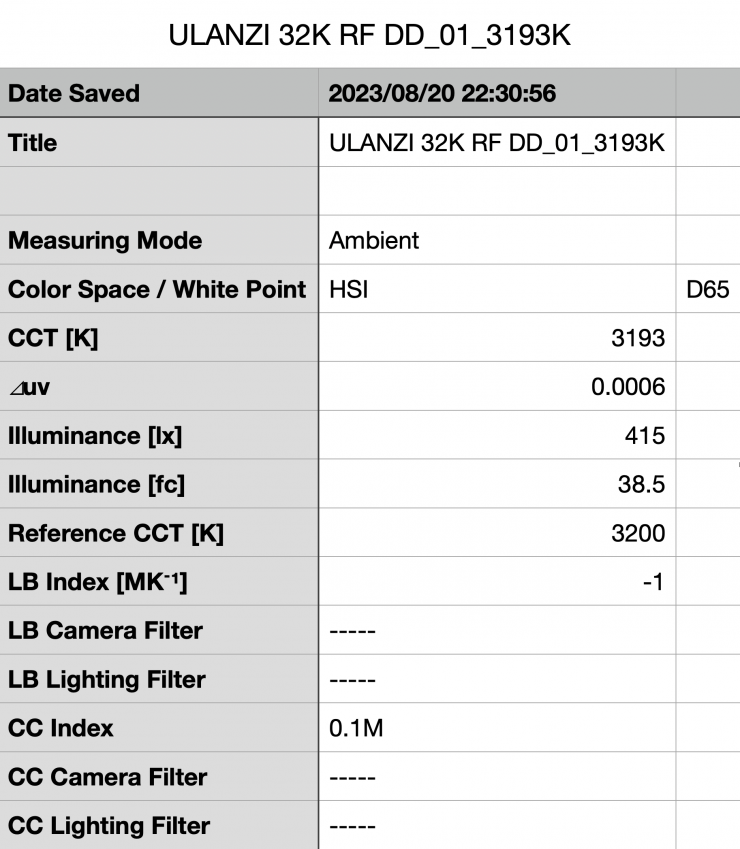
Above you can see the light’s output when it was set at 3200K using its reflector and diffusion dome was 415 lx (38.5 fc).
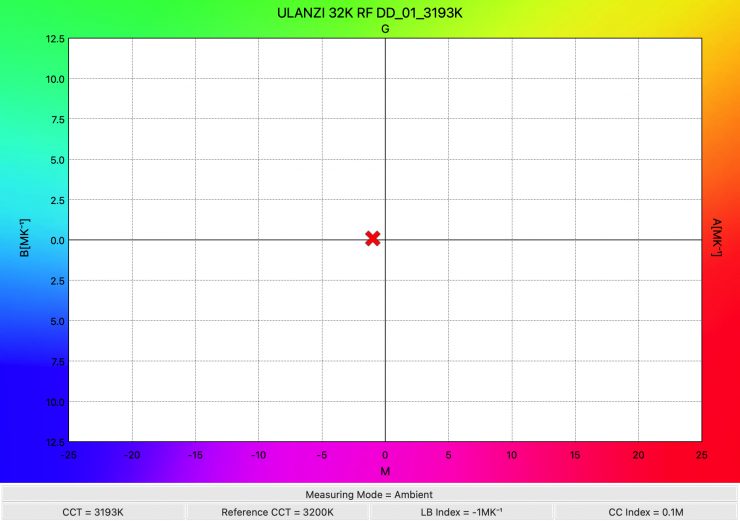
As far as CCT accuracy goes, it recorded an almost perfect reading of 3193K. The combination of the reflector and diffusion dome at 3200K gives you a very accurate CCT reading, unlike at 5600K
How does it perform at various CCT Settings?
Summary of results (Open Face)
| SETTING | OUTPUT | CCT READING |
| 2500K | 829 lx | 2690K |
| 3200K | 835 lx | 3470K |
| 4500K | 952 lx | 4699K |
| 5600K | 987 lx | 5739K |
| 6500K | 1060 lx | 6976K |
These results show me that the light’s output varies by 21.8% depending on what CCT temperature you are using between 2500-6500K.
The CCT accuracy across the range is not very good. It was 476K off at 6500K. These readings tell me the light doesn’t have very good CCT consistency across its range when used open face.
Summary of results (Reflector)
| SETTING | OUTPUT | CCT READING |
| 2500K | 1600 lx | 2670K |
| 3200K | 1780 lx | 3457K |
| 4500K | 1980 lx | 4609K |
| 5600K | 2080 lx | 5537K |
| 6500K | 2210 lx | 6610K |
These results show me that the light’s output varies by 27.6% depending on what CCT temperature you are using between 2500-6500K.
The CCT accuracy across the range was ok and a lot better than when the light is used open face. It was no more than 170K off at any reading which tells me the light has decent enough CCT consistency across its range, especially from 4500-6500K.
CCT consistency & linear output when dimming the light
Now, what you should always do when testing lights is to see if the CCT remains consistent when dimming the light. Just because you set a light at say 5600K, that doesn’t mean that the CCT will remain stable as you start dimming the fixture down. I also wanted to see how linear the dimming curve was.
I decided to do a series of tests at 100%/75%/50%/25%10% to see if the CCT being recorded changed. This was done at a distance of 1m using a Sekonic C-800. These tests were done at 5600K using the standard reflector.
| CCT READING | OUTPUT | INTENSITY % |
| 5537K | 2080 lx | 100 |
| 5542K | 1750 lx | 75 |
| 5552K | 1420 lx | 50 |
| 5537K | 1060 lx | 25 |
| 5535K | 836 lx | 10 |
The Ulanzi LT028’s CCT consistency was excellent. My testing showed that the CCT readings varied by only 17K. This is one of the best results i have ever recorded from ant LED light.
As far as how linear the output is when you start dimming the light, at 50% output it had 31.73% less output than when used at 100%. At 25% it had 49.03% less output than when used at 100%. At 10% output, it had 59.8% less output than when used at 100%. This shows me that the light’s dimming curve is not in any way linear. This is the worst result I have seen from any LED light I have tested.
Color Rendering
So now that we have seen how much output the Ulanzi LT028 produces, how does it perform when it comes to replicating accurate colors?
Ulanzi LT028 5600K (Reflector)
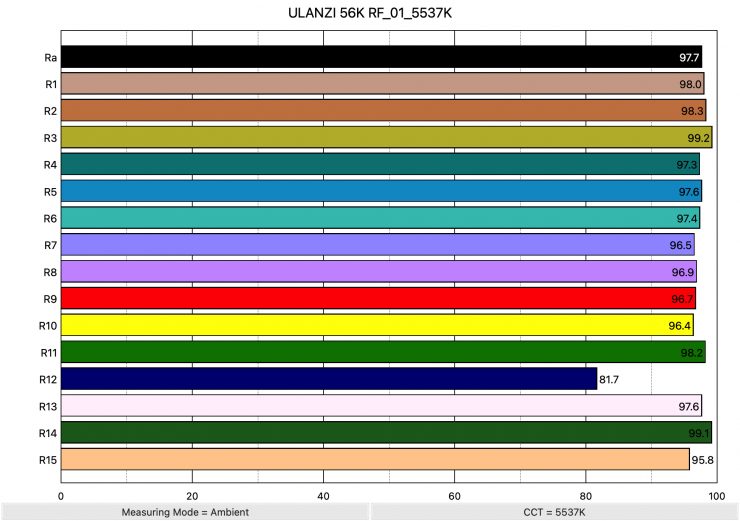
Above you can see that when the light was set at 5600K and used with its reflector, recorded an average CRI (R1-R8) of 97.7 and an extended CRI (R1-R15) of 96.44. For replicating accurate skin tones it recorded 96.7 for R9 (red), 97.6 for R13 (closest to caucasian skin tones), and 95.8 for R15 (closest to Asian skin tones). These were excellent results, and only R12 (Blue), was under 90.
As a comparison, the amaran COB 60x when used at 5600K had an extended CRI of 95.90.
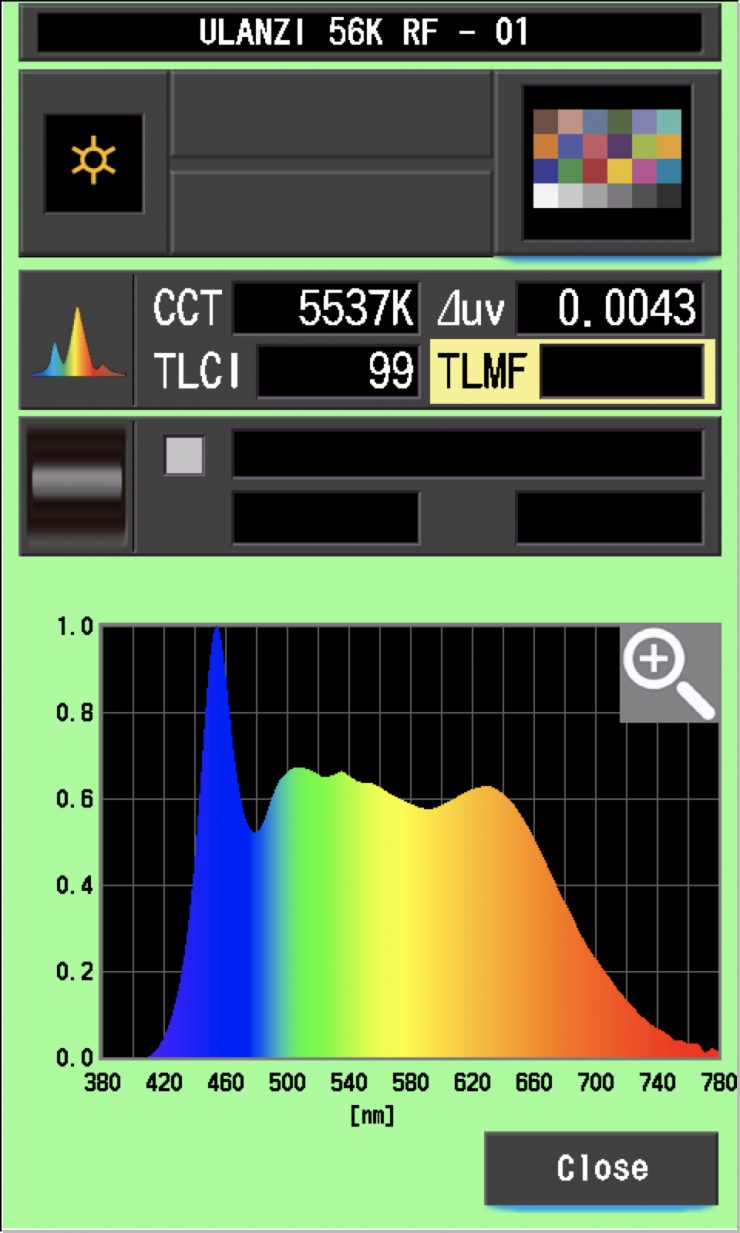
The Ulanzi LT028 when set at 5600K recorded a TLCI score of 99. This was a good result.
Ulanzi LT028 3200K (Reflector)
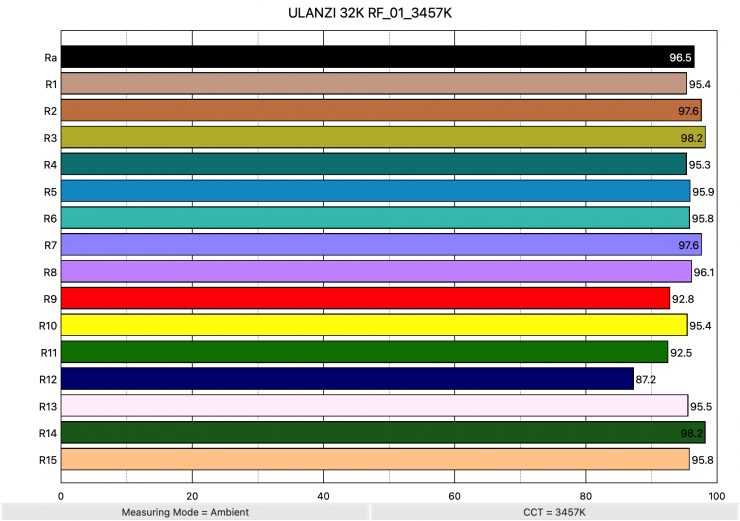
Above you can see the scores for when the light was used at 3200K. It recorded an average CRI (R1-R8) of 96.5 and an extended CRI (R1-R15) of 95.28. For replicating accurate skin tones it recorded 92.8 for R9 (red), 95.5 for R13 (closest to caucasian skin tones), and 95.8 for R15 (closest to Asian skin tones). These were good results, although not quite as good as when the light is used at 5600K. Only R12 was below 90, but not by much.
As a comparison, the amaran COB 60x when used at 3200K had an extended CRI of 97.04.
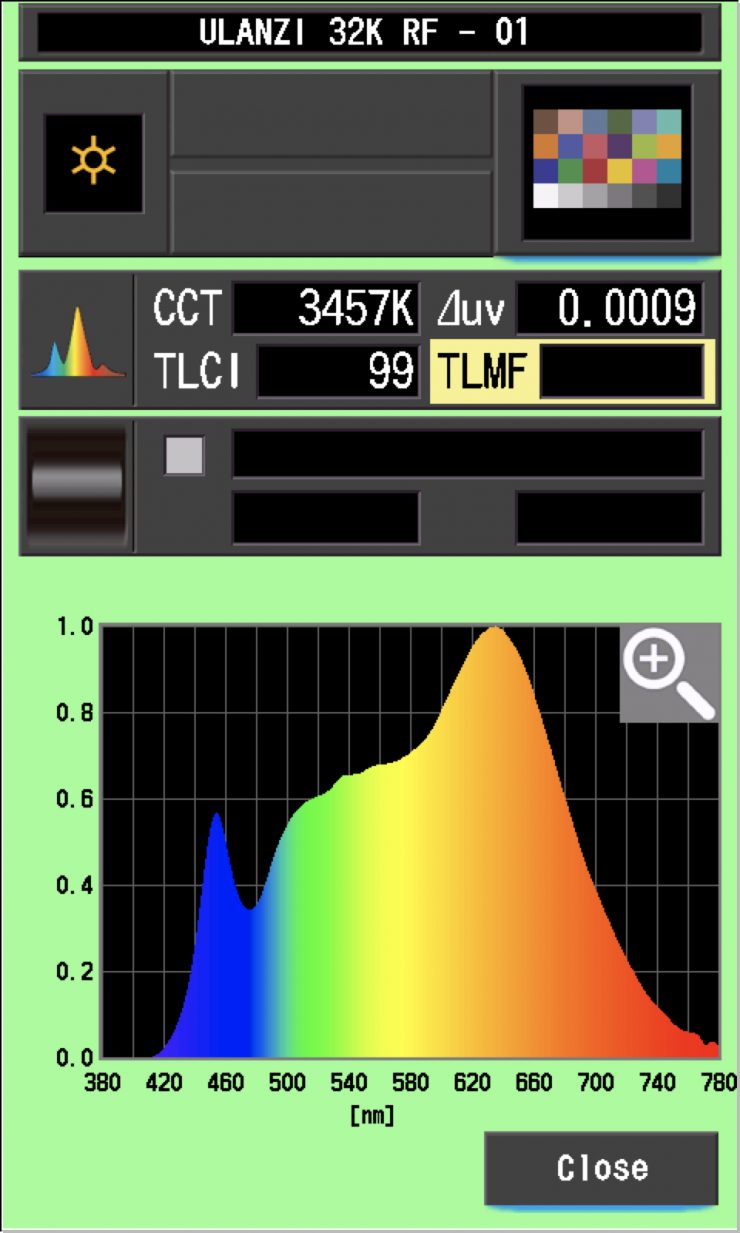
The Ulanzi LT028, when set at 3200K recorded a TLCI score of 99.
Ulanzi LT028 5600K (Open Face)
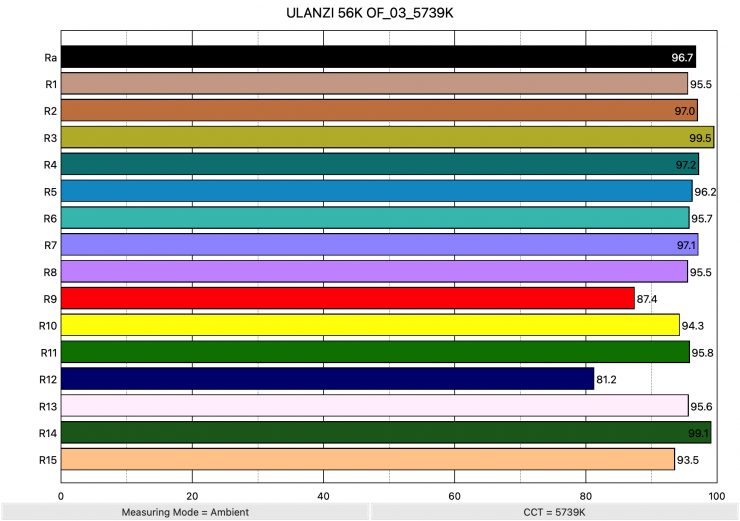
Above you can see that when the light was set at 5600K and used open face recorded an average CRI (R1-R8) of 96.7 and an extended CRI (R1-R15) of 94.70. For replicating accurate skin tones it recorded 87.4 for R9 (Red), 95.6 for R13 (closest to caucasian skin tones), and 93.5 for R15 (closest to Asian skin tones). These were decent results, and only R12 (Blue) and R9 (Red) were under 90.
What was interesting to see is that the color rendering scores were better when using the light with its reflector than when using it open face when set at 5600K.
Ulanzi LT028 3200K (Open Face)
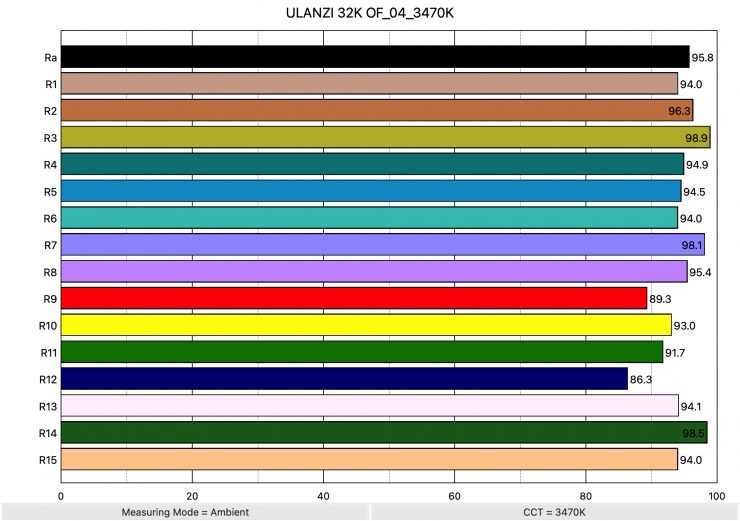
Above you can see that when the light was set at 3200K and used open face it recorded an average CRI (R1-R8) of 95.8 and an extended CRI (R1-R15) of 94.2. For replicating accurate skin tones it recorded for R9 89.3 (red), 94.1 for R13 (closest to caucasian skin tones), and 94.0 for R15 (closest to Asian skin tones). These were good results, with only R12 (Blue) and R9 (red) being below 90.
Again, just like at 5600K, the light wasn’t as color-accurate when used open face as it is when used with its reflector.
Ulanzi LT028 5600K Reflector & Diffusion Dome
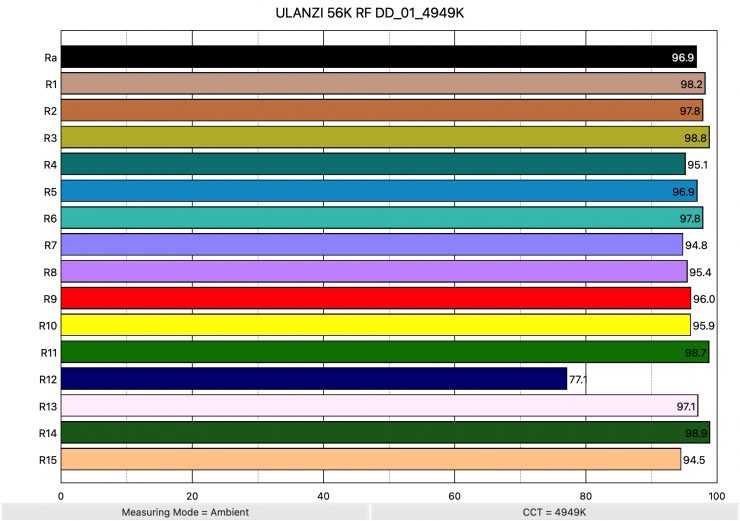
Above you can see that the light was set at 5600K and used with its reflector and diffusion dome recorded an average CRI (R1-R8) of 96.9 and an extended CRI (R1-R15) of 95.53. For replicating accurate skin tones it recorded 96.0 for R9 (red), 97.1 for R13 (closest to caucasian skin tones), and 94.5 for R15 (closest to Asian skin tones). These are good results, and only R12 (Blue), was under 90, however, it had a pretty bad score of just 77.1.
What this shows me is that the color rendering scores are still very good when using the light with its reflector and diffusion dome at 5600K.
Ulanzi LT028 3200K Reflector & Diffusion Dome
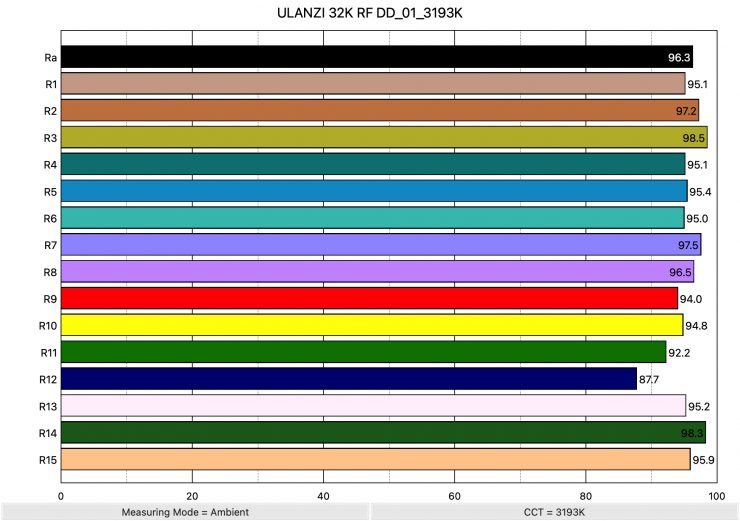
Above you can see that when the light was set at 3200K and used with its reflector and diffusion recorded an average CRI (R1-R8) of 96.3 and an extended CRI (R1-R15) of 95.22. For replicating accurate skin tones it recorded 94.0 for R9 (red), 95.2 for R13 (closest to caucasian skin tones), and 95.9 for R15 (closest to Asian skin tones). These are good results, and only R12 (Blue), was slightly under 90.
What this shows me is that the color rendering scores are still very good even when using the light with its reflector and diffusion dome at 3200K.
CC Index & ⊿uv
The CC Index displays the CC correction value and whether any magenta or green need to be added or subtracted. 1 CC corresponds to 035 Kodak CC values or 1/8 Rosco filter values. Any reading less than +1.00 or -1.00 and you’re probably not going to need to make any kind of adjustment. The ⊿uv is the value to show how much this light is away from being an ideal light source (black body radiation = incandescent lamp). As with the CC Index you want this number to theoretically be zero. Kelvin is not a linear value, so we need to convert from Kelvin to MK-1 to compare the values of color temperature. To calculate from Kelvin to Mired is MK-1= 1*1000000/Kelvin. While this may sound confusing, it is the only way of measuring if the Kelvin shift is significant enough to warrant having to use a filter for correction. Below are the results for the Ulanzi LT028:
Ulanzi LT028 Kelvin Vs MK-1 (Reflector)
| Kelvin | Difference in K | MK-1 | Difference in MK-1 | |
| SET VALUE | 2500K | 0 | 400 | 0 |
| ACTUAL READING | 2670K | 170 | 374.53 | 25.47 MK-1 |
| SET VALUE | 3200K | 0 | 312.5 | 0 |
| ACTUAL READING | 3457K | 257 | 289.26 | 23.24 MK-1 |
| SET VALUE | 4500K | 0 | 222.22 | 0 |
| ACTUAL READING | 4609K | 109 | 216.96 | 5.26 MK-1 |
| SET VALUE | 5600K | 0 | 178.57 | 0 |
| ACTUAL READING | 5537K | 63 | 180.60 | -2.03 MK-1 |
| SET VALUE | 6500K | 0 | 158.84 | 0 |
| ACTUAL READING | 6610K | 110 | 151.28 | 7.56 |
These figures might look confusing, but what they tell me is that the light is not very CCT accurate across its 2500-6500K range. Only at 4500K and 5600K did it perform well. Any MK-1 score that is under -9/9 means you wouldn’t have to use any color correction gels. Any MK-1 score that is under -6/6 is a very good result. The MK-1 scores for 2500K and 3200K were the worst I have seen from any LED light I have reviewed.
Okay, now let’s look at the CC INDEX & ⊿uv.
Ulanzi LT028 CC INDEX & ⊿uv
| CC INDEX | ⊿uv | |
| 2500K | 1.0M | 0.0069 |
| 3200K | 0.2M | 0.0009 |
| 4500K | 0.2M | 0.0016 |
| 5600K | 0.3M | 0.0043 |
| 6500K | 0.5M | 0.0082 |
These weren’t great results. The light certainly does lean slightly magenta from 3200-6500K, but the amount isn’t high enough to be of any big concern. However, at 2500K the light leans massively green with a CC Index score of 1.0M.
TM-30
TM-30 is a relatively new color rendering standard that was developed to deal with the limitations of CRI. TM-30 looks at 99 individual colors. These 99 colors are categorized into seven groups: nature, skin color, textiles, paints, plastics, printed material, and color systems.
TM-30 scores go from 0 – 100. The higher the score, the more accurate a light is at producing colors. Any TM-30 Rf score in the ’90s is considered to be good. What is interesting and something that you need to be very aware of is that two separate light sources with the exact same CRI scores can render colors very differently. A light with a high CRI rating could have a low TM-30 score. Conversely, a light with a good TM-30 score could have a bad CRI score.
Now, there are two measurements associated with TM-30, Rf and Rg.
Rf (Color Fidelity)
Rg (Color Gamut)
With Rf value, ideally, you want a score in the 90’s.
With Rg value, a score below 100 indicates that the light source renders colors with less saturation than the reference source. So ideally you want this score to be 100.
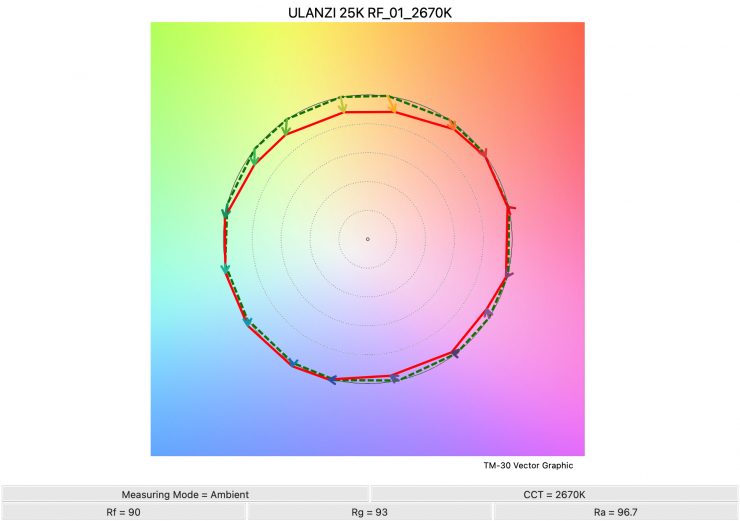
2500K 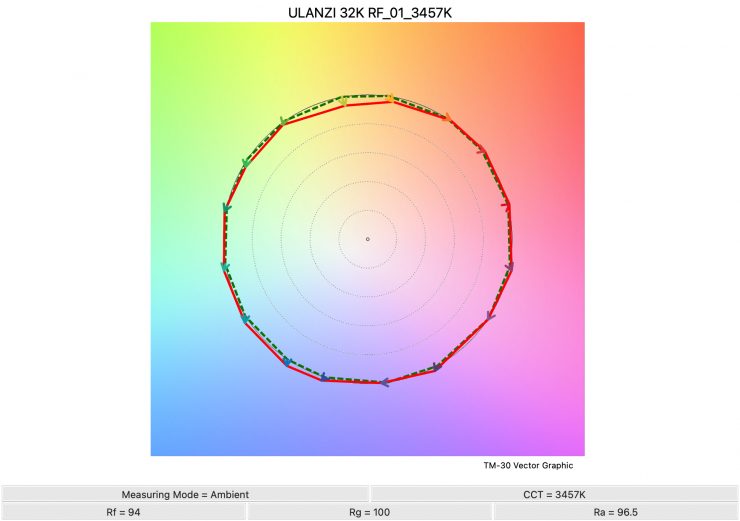
3200K 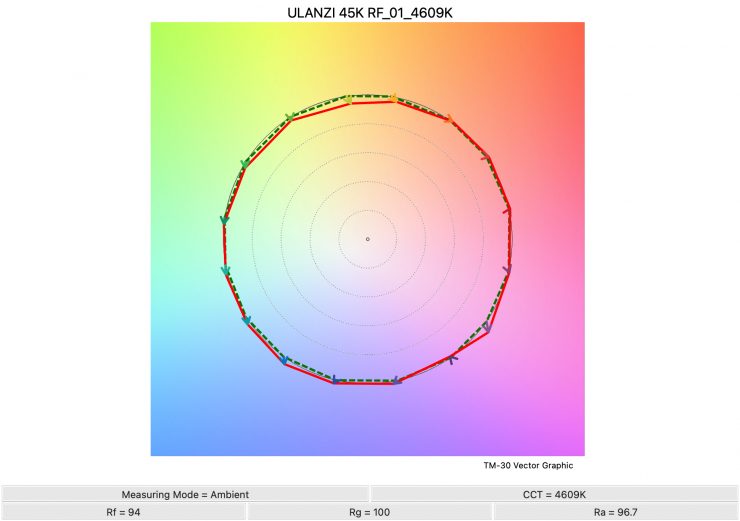
4500K 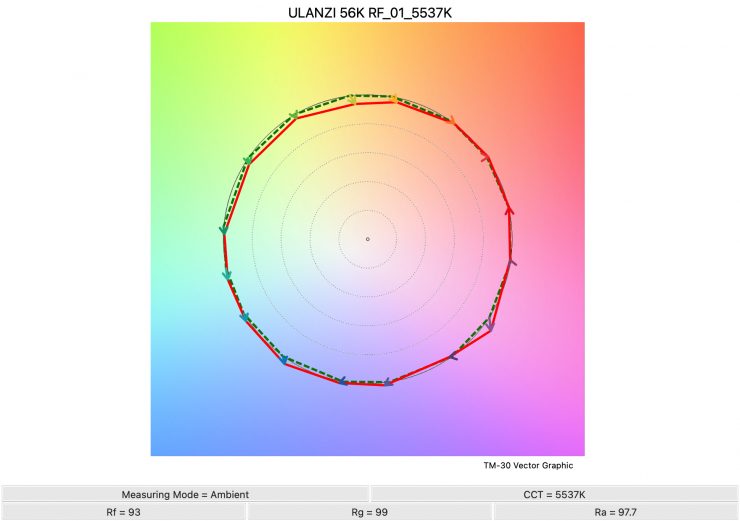
5600K 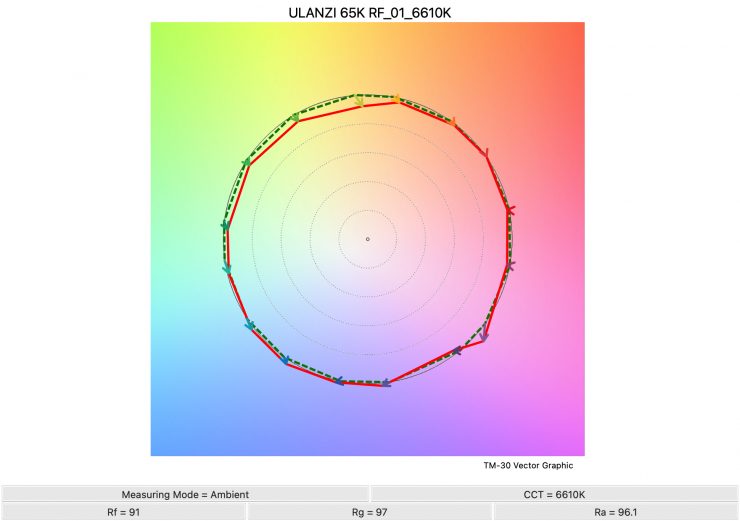
6500K
Above you can see the scores for the Ulanzi LT028 at various CCT settings. Below I have listed the figures as well.
Here are the results:
| Rf | Rg | |
| 2500K | 90 | 93 |
| 3200K | 94 | 100 |
| 4500K | 94 | 100 |
| 5600K | 93 | 99 |
| 6500K | 91 | 97 |
The TM-30 scores were okay, but you can clearly see from the TM-30 images why the light leans green.
SSI
SSI (Spectral Similarity Index) was developed by the Sci-Tech Council of the Academy. SSI gives me the ability to set any light as a standard, or use predefined standards (such as CIE D55), and then give other lights an SSI score based on how well they will match standards such as CIE D55. This way I can measure spectral response and compare it directly against an ideal light source. This is actually a much better test than recording CRI scores, however, just lie any individual test it doesn’t tell you the full story.
Ulanzi LT028 3200K (Open Face)
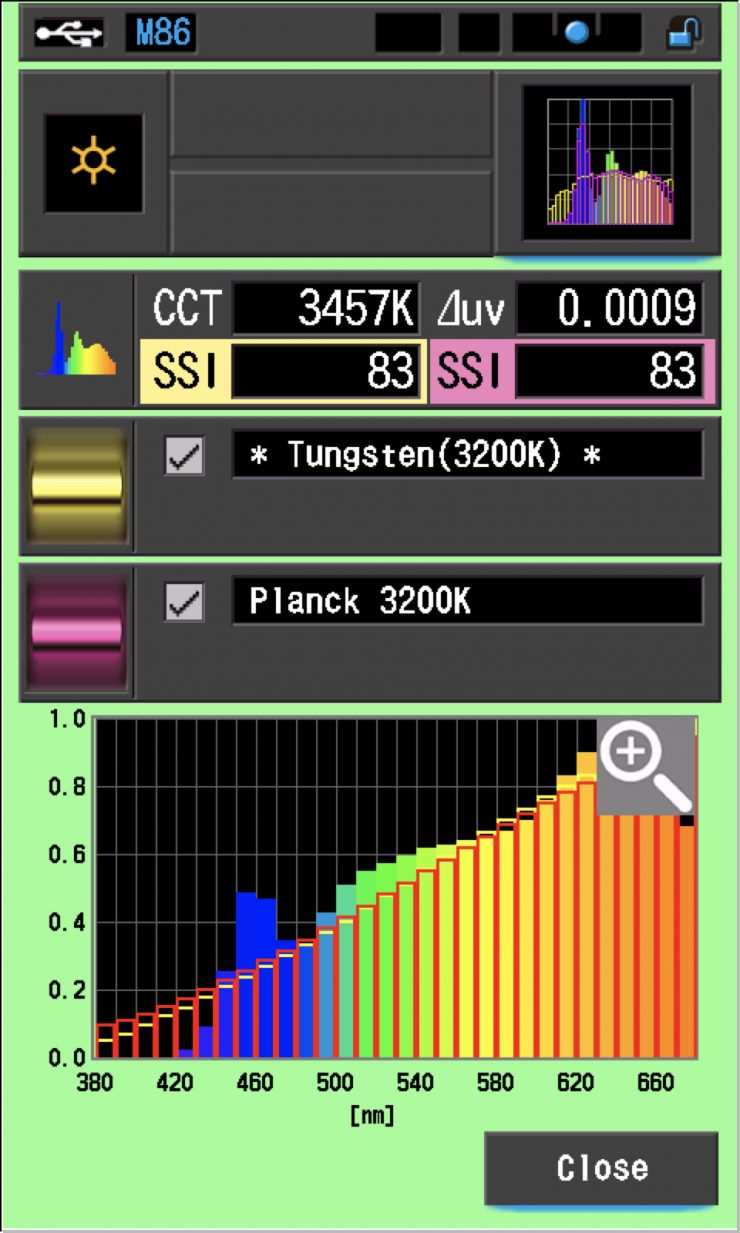
In this graph, the red bars indicate a perfect Planck 3200K source. The gold bars indicate a perfect 3200K Tungsten source. This lets us compare how close to a perfect 3200K lighting source the Ulanzi LT028 is. Any SSI score in the high 70’s, low ’80s is very good for a 3200K LED light. The results for the Ulanzi were pretty good when used at 3200K. As you can see, LED lights have a hard time replicating colors below about 450nm.
Ulanzi LT028 5600K (Open Face)
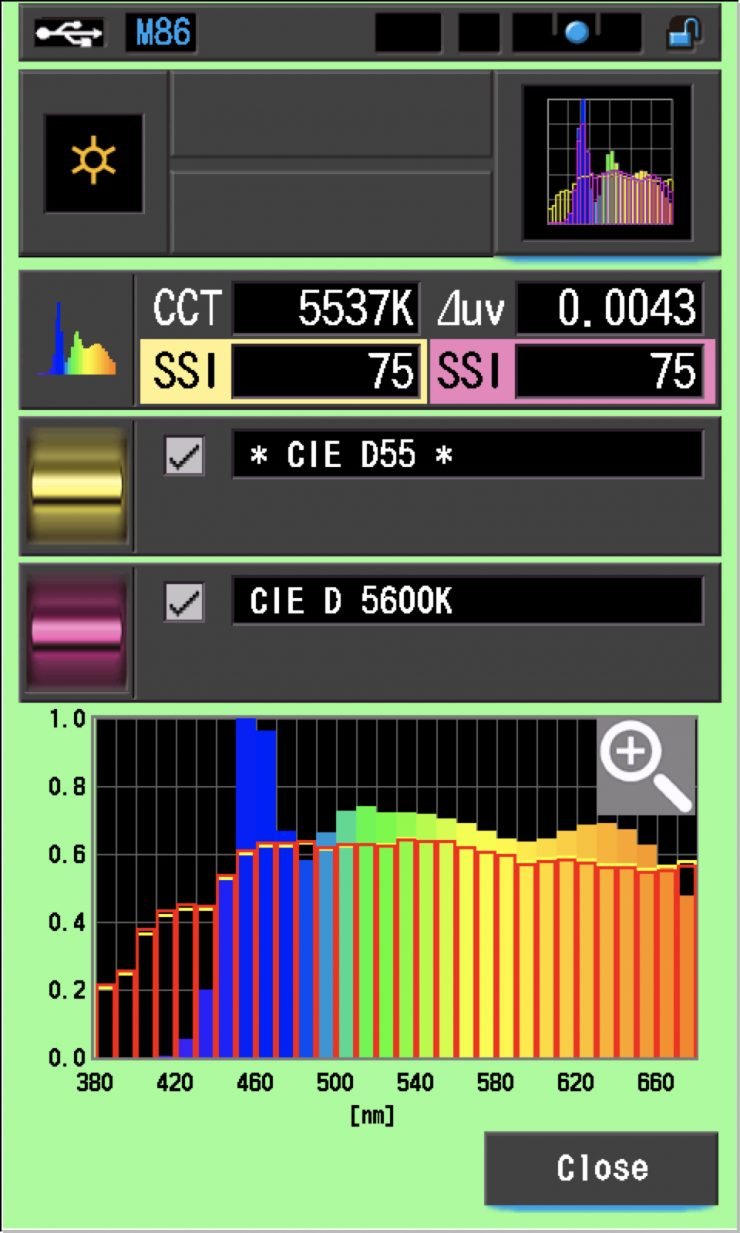
In the graph above the gold bars indicate a perfect CIE D55 source. The red bars indicate a perfect CIE D 5600K source. This lets us compare how close to a perfect 5600K lighting source the Ulanzi LT028 is. A score in the low 70’s is typical for a 5600K LED source.
The main reason we want to record SSI scores is so we can see how well they match with other lights. As an example, I wanted to see how well the Ulanzi LT028 matched the Prolycht Orion 675 FS and the ARRI Orbiter. Below you can see the results.
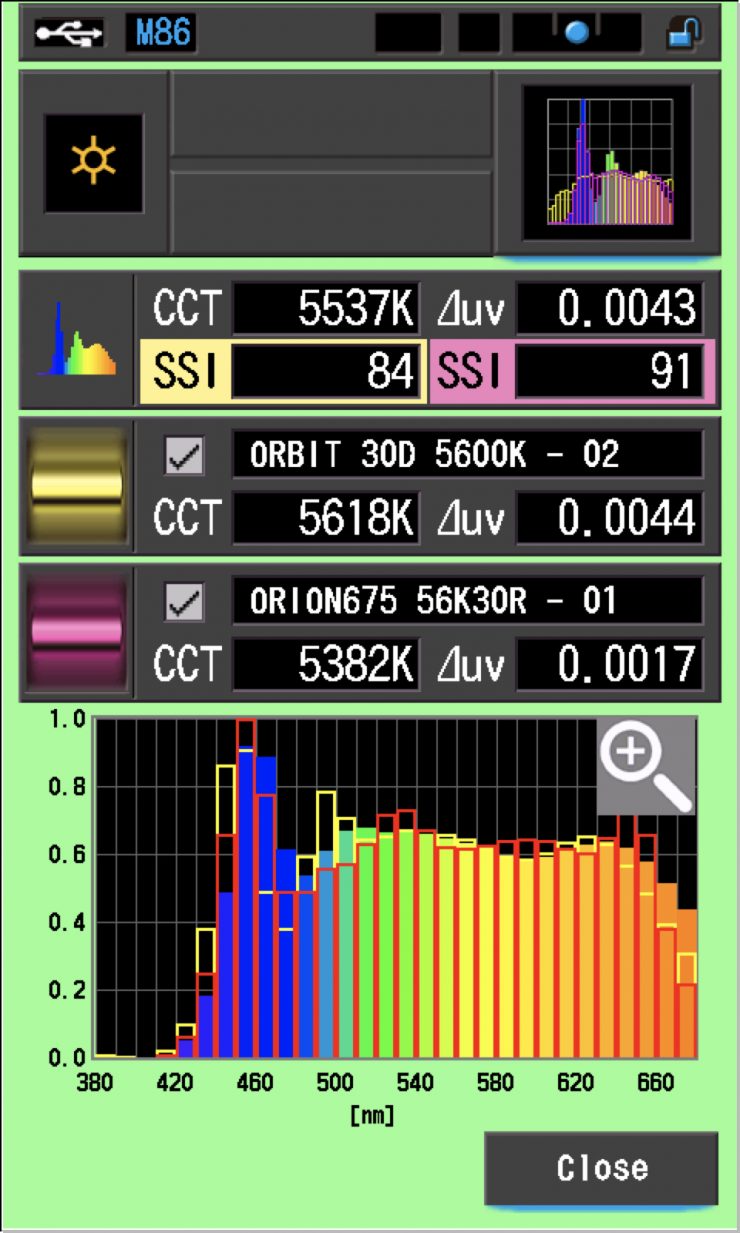
As you can see both lights are a decent enough match to the Ulanzi LT028. Any score in the high ’80s and low 90s would be enough to get a decent enough match. In saying that, the light was a slightly better match to the Prolycht Orion 675 FS than it was with the ARRI Orbiter.
As another test, I thought I would compare those same lights against the Ulanzi LT028 at 3200K. Below you can see the results.
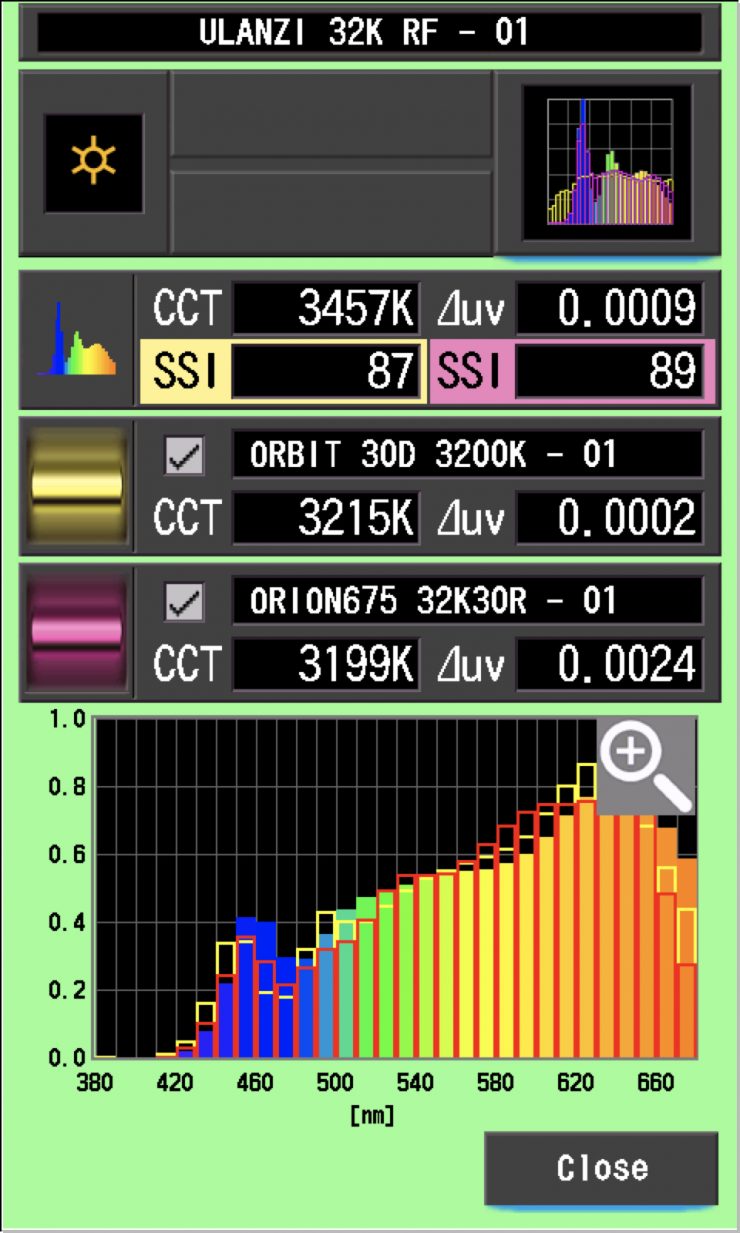
As you can see, the ZUlanzi LT028 was a decent enough match to the ARRI Orbiter and Prolycht Orion 675 FS at 3200K. Very few lights from different manufacturers are ever going to be an exact match.
Ok, so let’s do some more comparisons. This time I wanted to see how well the Ulanzi LT028 when used with its reflector matched the light when it was used open face and with its diffusion dome and reflector.
As you can see, with a score of 94 and 94, the light isn’t a perfect match when used both Open face and with its reflector at both 3200K and 5600K. However, when you compare it being used with its reflector and with its diffusion dome and reflector it is almost a perfect match at 5600k and it was a perfect match at 3200K. This is actually the first time I have ever gotten a perfect 100 SSI score.
SSI tests are a great way of telling you what lights you own or use will work well together.
Spectral Distribution
Ulanzi LT028 5600K
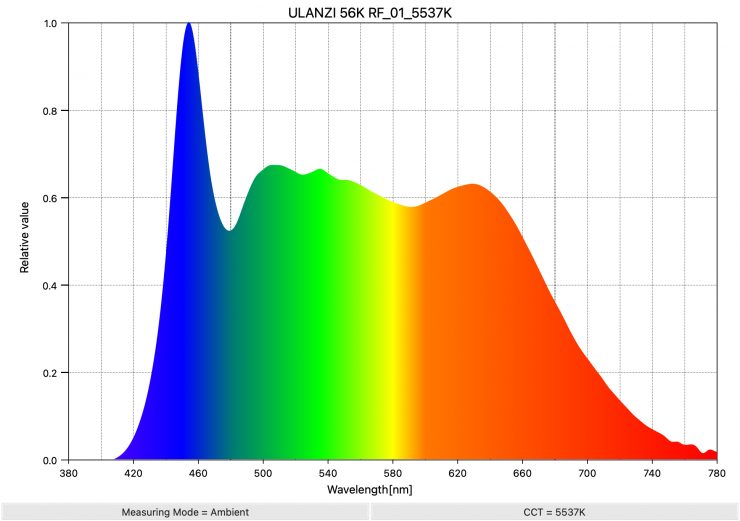
Above you can see the spectral distribution of the Ulanzi LT028 when it is set at 5600K. The spectral distribution is reasonably decent and full for a Bi-color LED light.
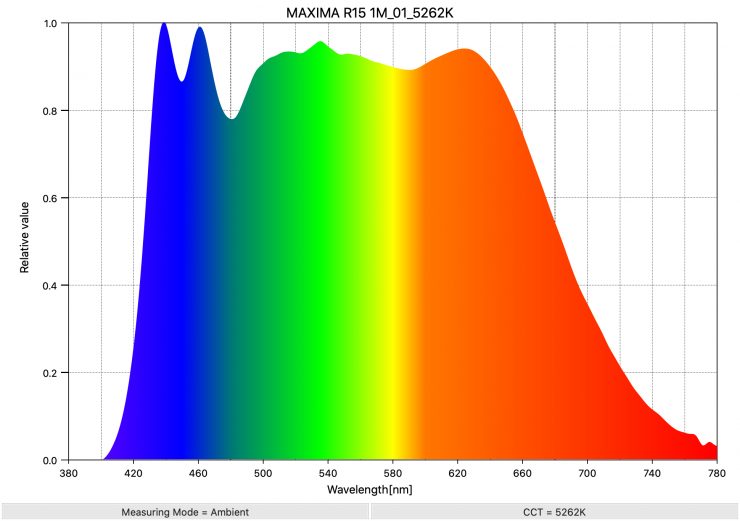
If you want to see what a really good spectral response looks like for a LED light at 5600K, above is the result for the Maxima 3.
Ulanzi LT028 3200K
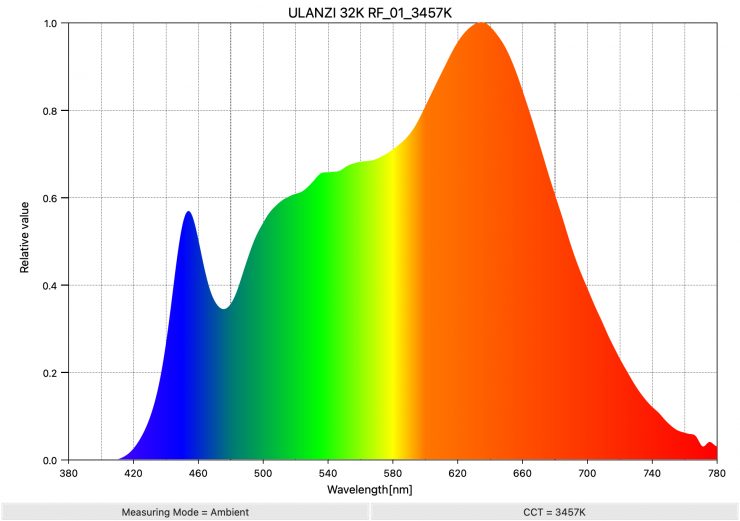
Above you can see the spectral distribution of the Ulanzi LT028 when it is set at 3200K. The spectral distribution is nice and even.
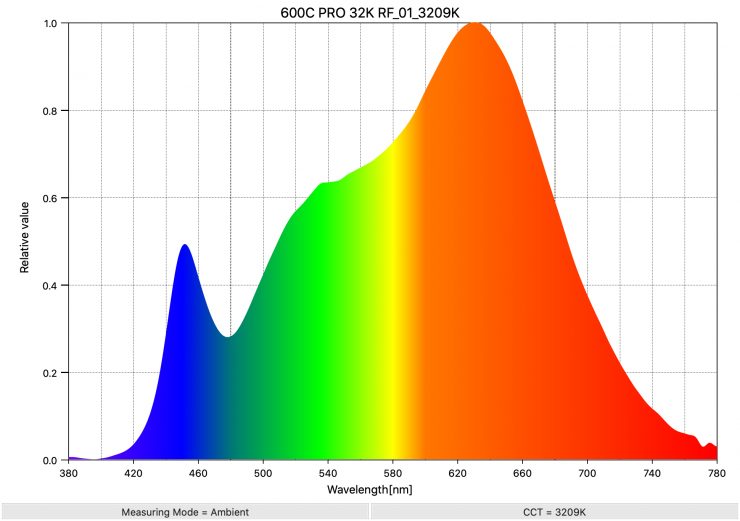
As a comparison, above you can see the spectral distribution of the Aputure 600c Pro when it is set at 3200K.
Real-World Performance & Quality of Light
As I always say, photometric scores only tell you part of the story. So let’s find out if the scores from the Ulanzi LT028 translate into good real-world performance.
The photometric results can only give me scientific data and it is much more important for me to see how the light looks and performs. Contrary to popular belief, if you are in the business of making lights you don’t want to try and achieve perfect scores because perfect scientific scores don’t equate to a light looking good. A good light should look good to a camera because, after all, that is what is capturing the image. Cameras and our eyes see differently and ideally, you want to use a light that looks good to your camera. There’s a bit of alchemy in knowing what to prioritize in order to render colors that appear accurate, natural, and pleasing. It’s not just about hitting certain numbers.
Lighting really comes down to how you use the light and having a great light isn’t suddenly going to produce better results for you unless you know what you are doing.
When you use the light with its reflector and diffusion dome, the output gets reduced so much that you really need to have the light very close to your subject for it to do much. As I mentioned earlier in the review, the output at 1m / 3.3′ when using the diffusion dome was just 415lx.
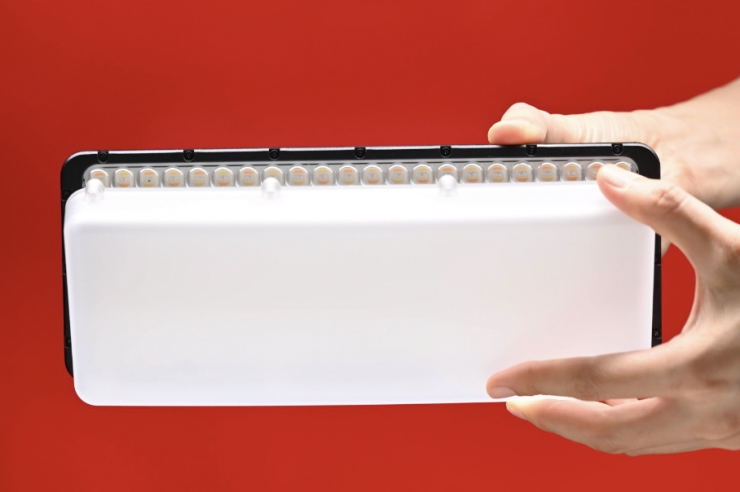
As a comparison for you, the Luxli Cello² when used at 5600K with diffusion has an output of 905lx at the same distance. That light draws just 30W, but it has more than double the output.
Above you can see a couple of quick example frames I did when using the light with its reflector and diffusion dome. No other lights are being used and this is in a small room.
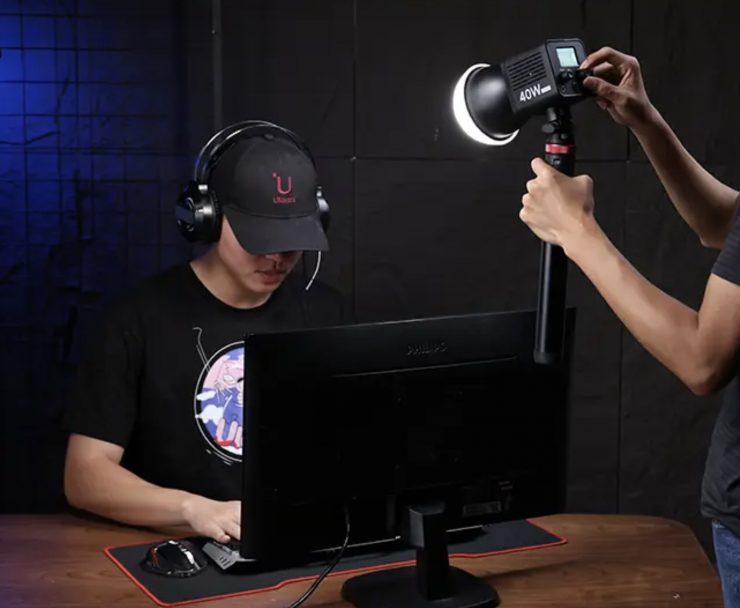
If you are going to make a COB light that is primarily designed to light up people you need to think about how to diffuse that light and how people are going to use it. I know companies like to list max output figures on their websites, but if the light is going to have to be primarily used with diffusion then you should also list what that output is. If you don’t the user may well get a shock when they realize the light isn’t nearly as bright as they thought it would be. At 5600K, when using the diffusion dome and reflector, the CCT gets massively altered and that is something potential customers also need to be aware of. Conversely, at 3200K it is almost spot on.
If you use the light open face you get a decent beam spread, however, if you use the included reflector there is definitely a giant hotspot and you can see how quickly the light intensity starts to fall away.
The reflector also does produce some color fringing on the edges of its beam, and even though it is hard to see in these photos, I found that at the top of the beam it produces, I could see LED stripes.
With a small-sized, low-power draw light, it certainly won’t be capable of lighting up a reasonable-sized room, however, it will add some ambient fill.
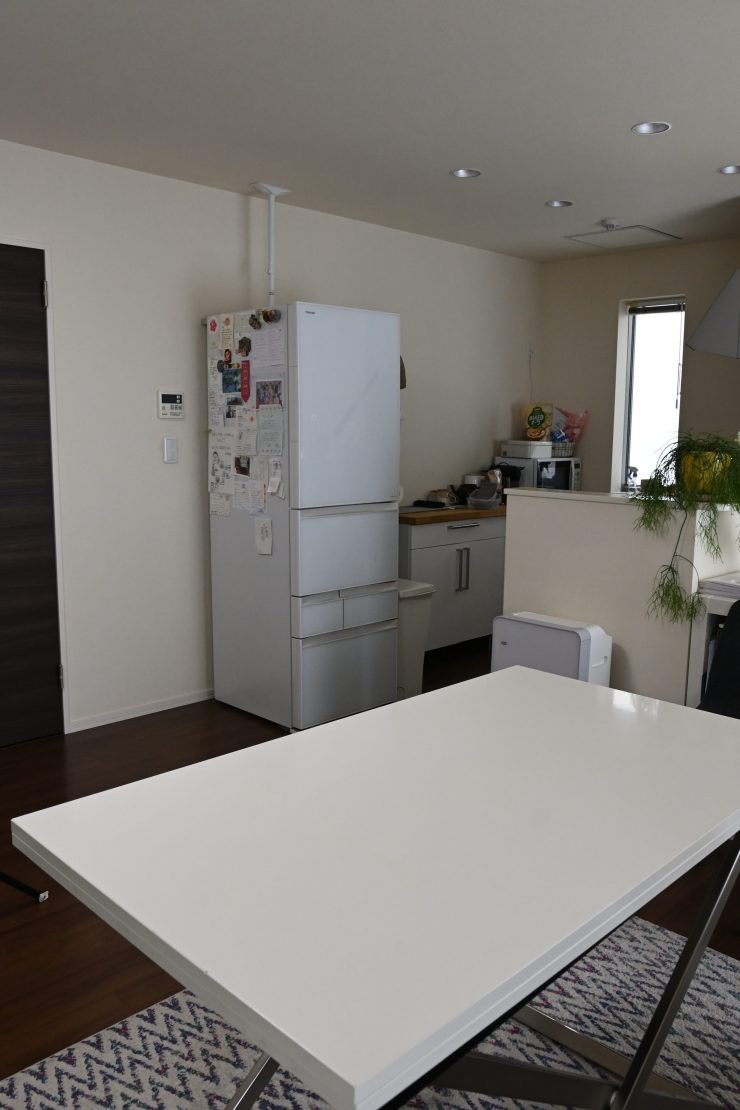
Reflector 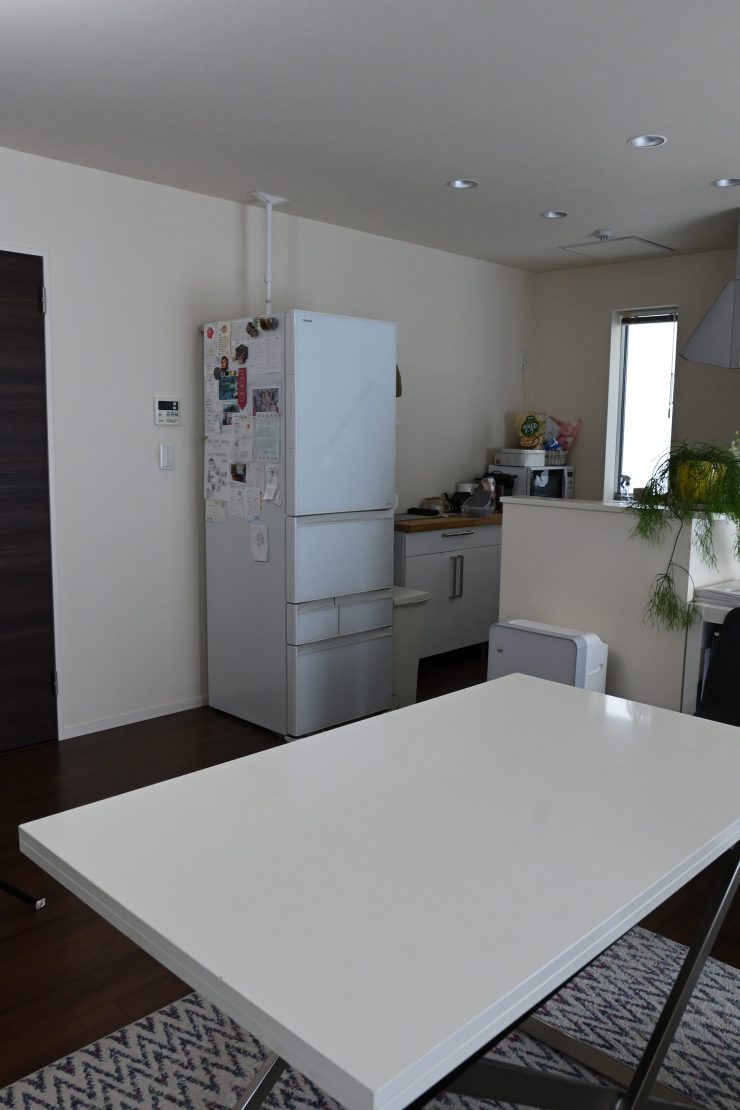
Open Face 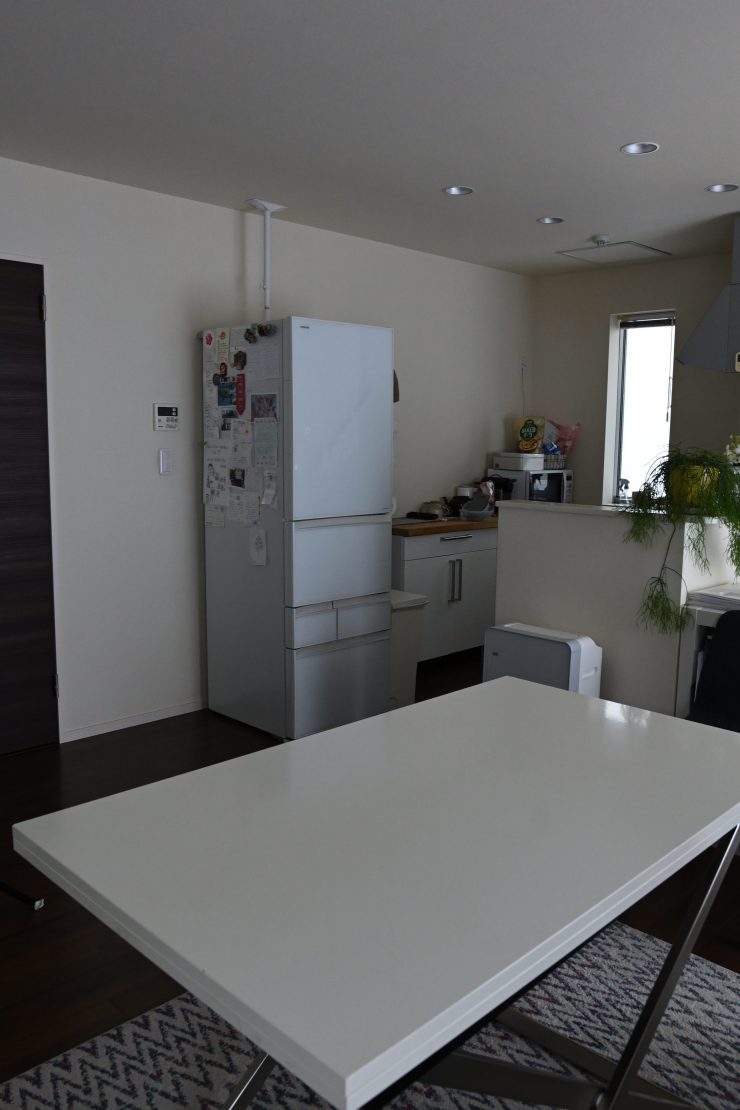
Light off
Above you can see an example of it being punched through a sheer curtain from outside when used with its reflector, open faced, and with the reflector and diffusion dome.
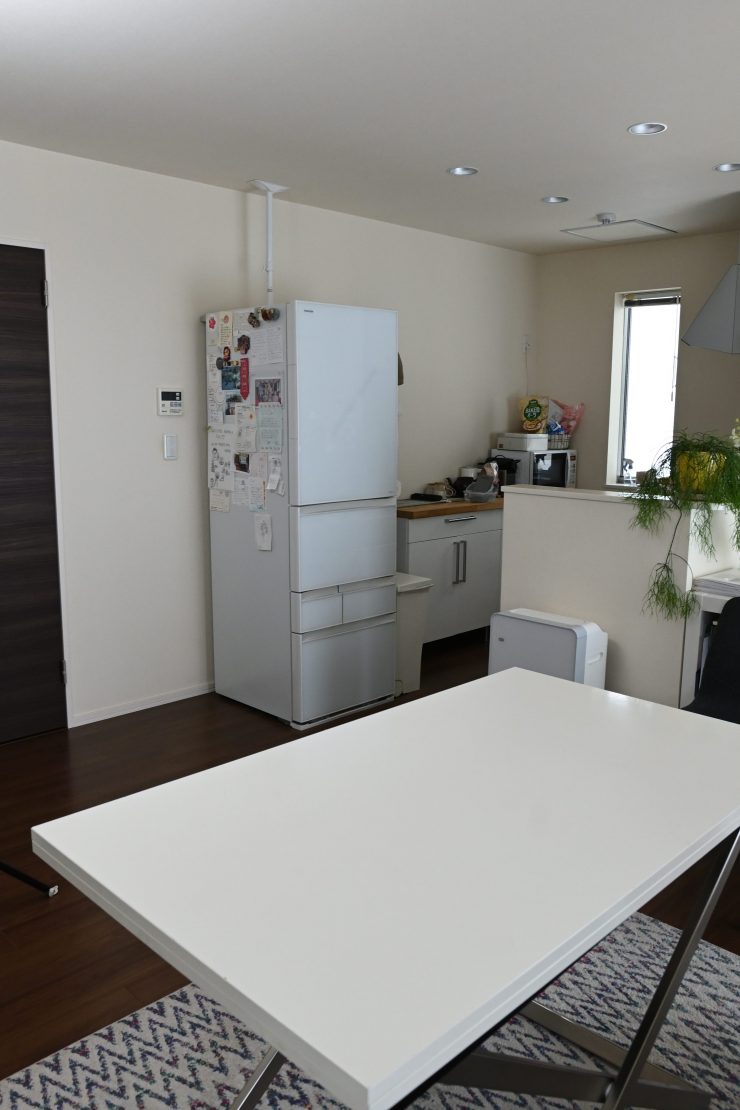
Reflector 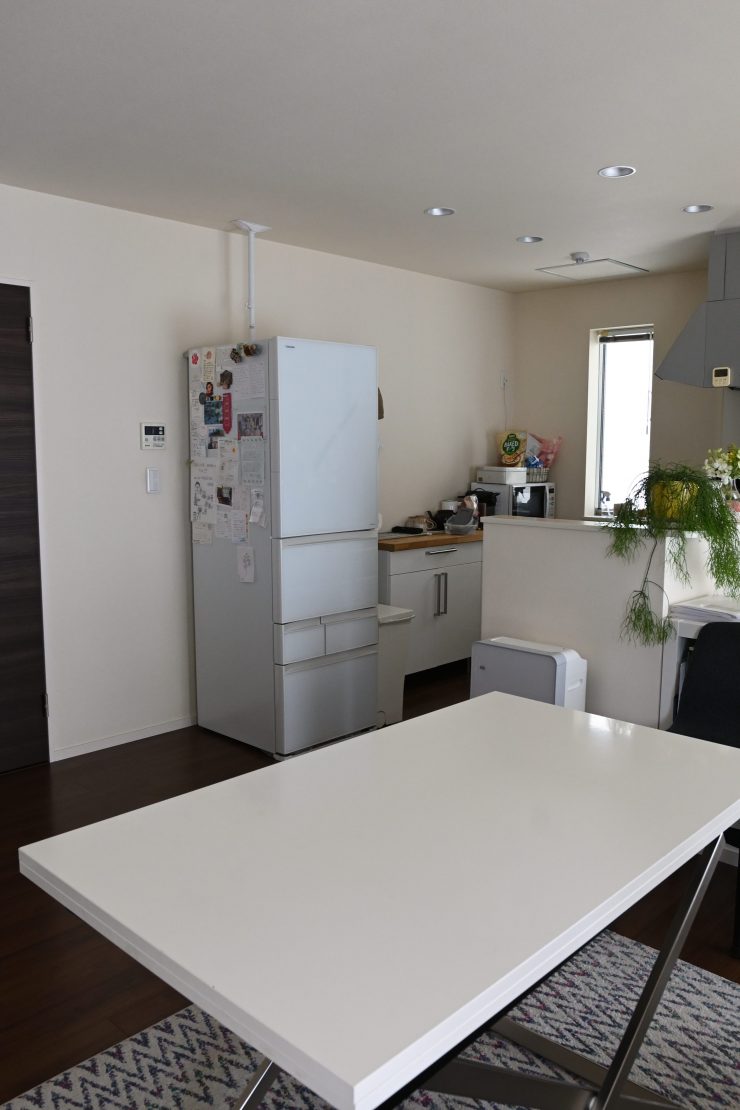
Open Face 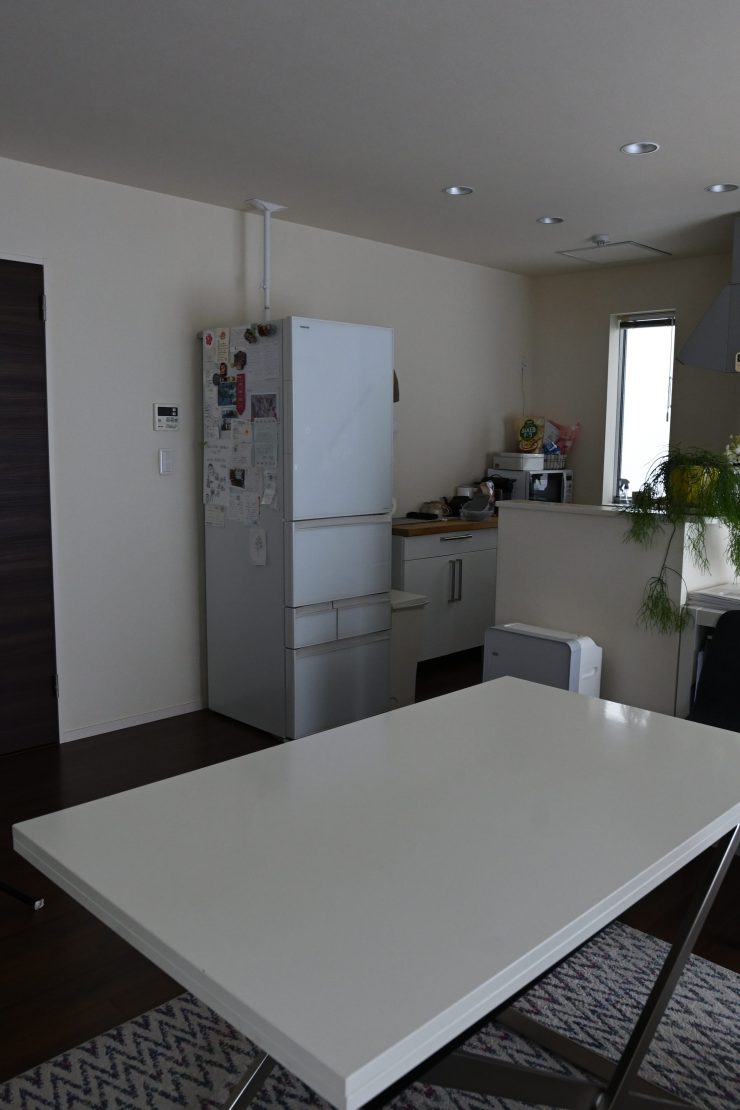
Light Off
Above you can see a comparison of the output difference between the light used with its reflector, open-faced, and with the light turned off. The light is being punched directly into the ceiling. I have kept the same camera settings for all three shots.
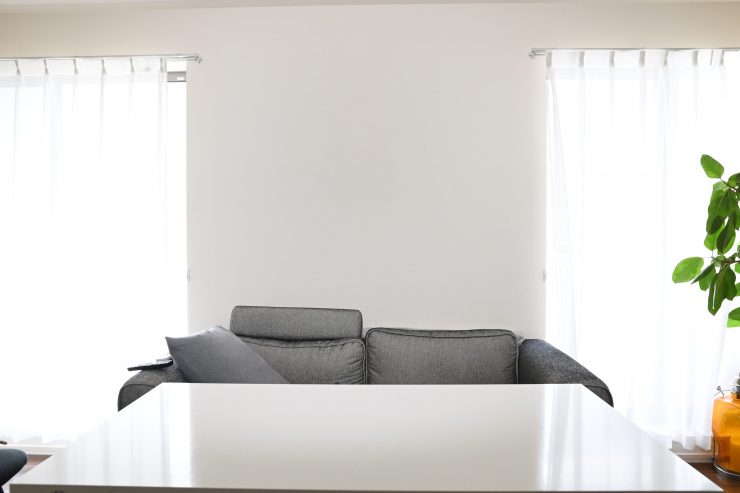
Reflector 
Open Face 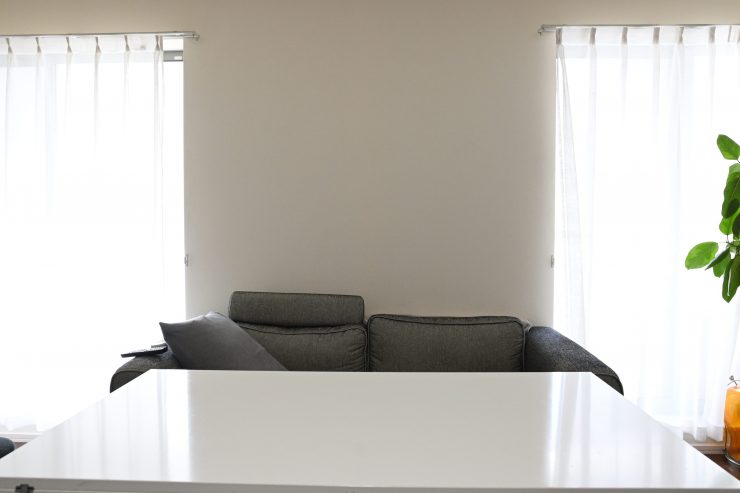
Diffusion dome & Reflector 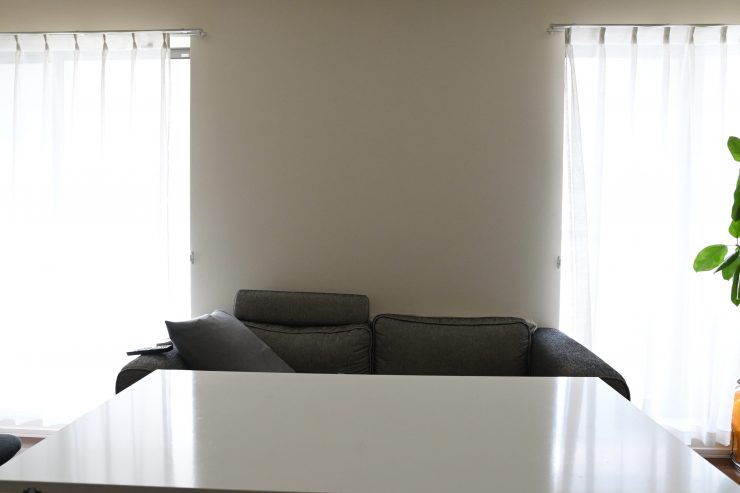
Light Off
Above you can see what the light looks like being used with its reflector, open face, with its reflector and diffusion dome at a distance of 3m / 9.9′.
What I also liked is that because the light is so small and it doesn’t weigh much, you could easily put it out on a boom arm. This is handy if you want to light up a table or even to use it as a backlight.
You could use the power supply as a counterweight, but because the light has an in-built battery and doesn’t weigh much you can get away with not having to do that.
Price & Availability
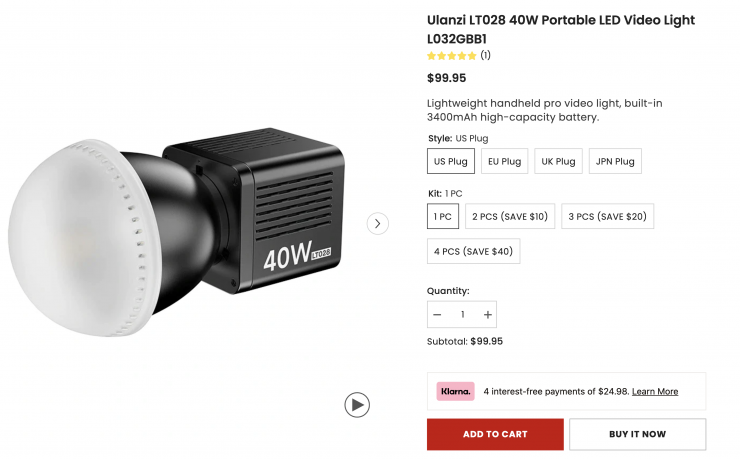
The Ulanzi LT028 retails for $99.95 USD and it is now available to purchase.
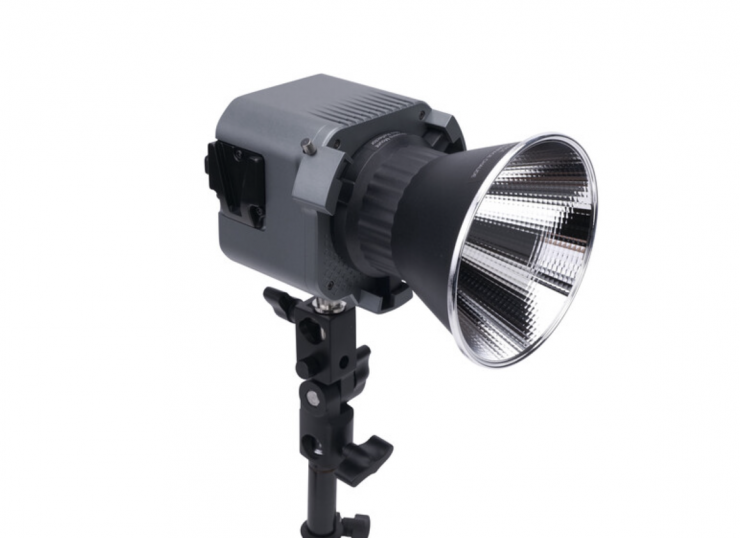
As a comparison, the more powerful (65W) amaran COB 60x S Bi-Color LED Monolight retails for $199 USD.
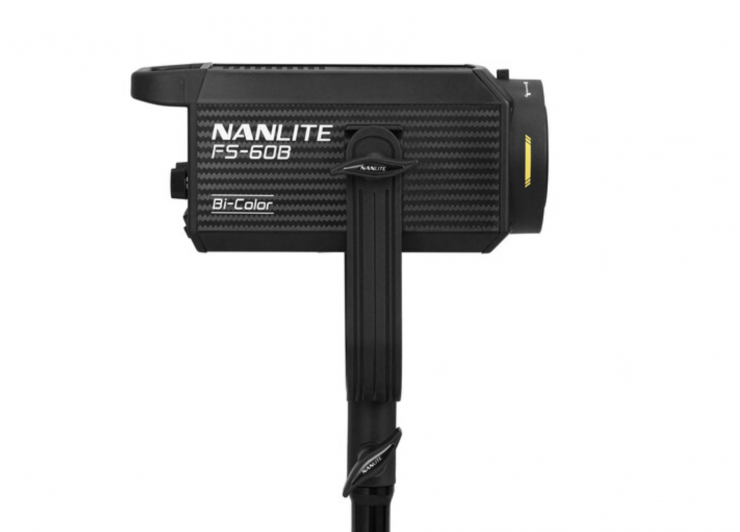
The Nanlite FS-60B Bi-Color Studio Spotlight is $143.20 USD (currently on sale).
Conclusion
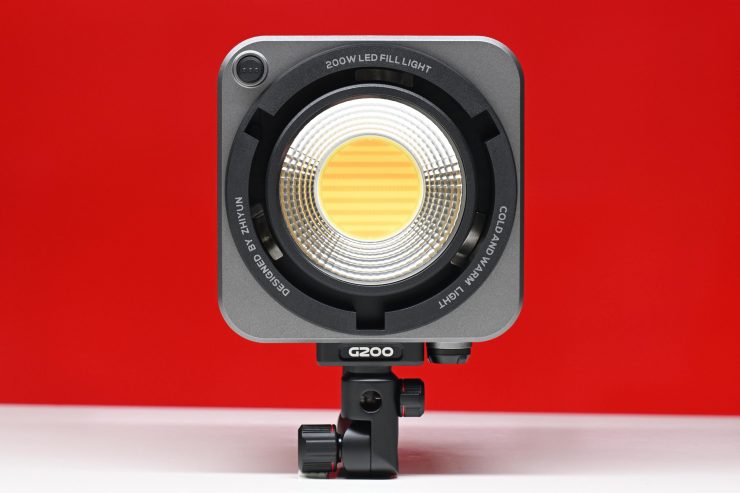
The Ulanzi LT028 is far from a perfect light, but it does offer good value for money if you are on a tight budget.
The tiny footprint of the Ulanzi LT028 means you could create a very small lightweight lighting kit using 2-4 of these fixtures. Everything could easily fit inside a small-sized backpack or Pelican case. As they feature internal batteries you also don’t need to carry around additional batteries separately to power it remotely on location when there is no mains power available.
Having a Mini Bowens Mount attachment has its pros and cons. As it doesn’t feature a full-sized Bowens mount, you don’t have access to nearly as many affordable lighting modifiers. However, in saying that, there are plenty of mini Bowens to full-sized Bowens mount adapters available.
The build quality is ok for a light at this price, and I am glad that Ulanzi is now including a couple of small ball head mounts in the kit for attaching it to a lightstand.
The light doesn’t have a ton of output, so that does limit what it can effectively be used for. COB lights are not good options for shining directly on talent with no diffusion, as they are not only uncomfortable to look at but also dangerous for your eyes. Yes, you can use the diffusion dome, but because it is so strong you lose way too much output to make it useful for a lot of lighting situations.
The test scores were a bit hit-and-miss. On one hand, the light has good color rendering scores, but on the other, it isn’t overly CCT accurate across its range, and it does lean magenta. It also doesn’t have very linear dimming.
Another issue Ulanzi is likely to face, through no fault of their own, is that it isn’t a brand a lot of people would be familiar with, especially in the lighting world. When you don’t have a track record of making certain products you need to either have an exceptionally good product that offers a lot more than its competition, or it needs to be considerably cheaper. Now, you should never judge a book by its cover, but that is the reality Ulanzi and other companies making lights for the first time face.
I might be sounding slightly overly critical in this review at times, but it is my job as a reviewer to give you the cold hard facts and to test the light in a way that is comprehensive so you know exactly what to expect. What you do have to factor in, is that this is a sub $100 USD light and you shouldn’t for one second think it is going to perform as well as lights that cost considerably more money. For its intended target audience, the Ulanzi LT028 is still a decent option, although it does face very stiff competition, especially when you can buy more powerful fixtures from established brands for not much more money.

